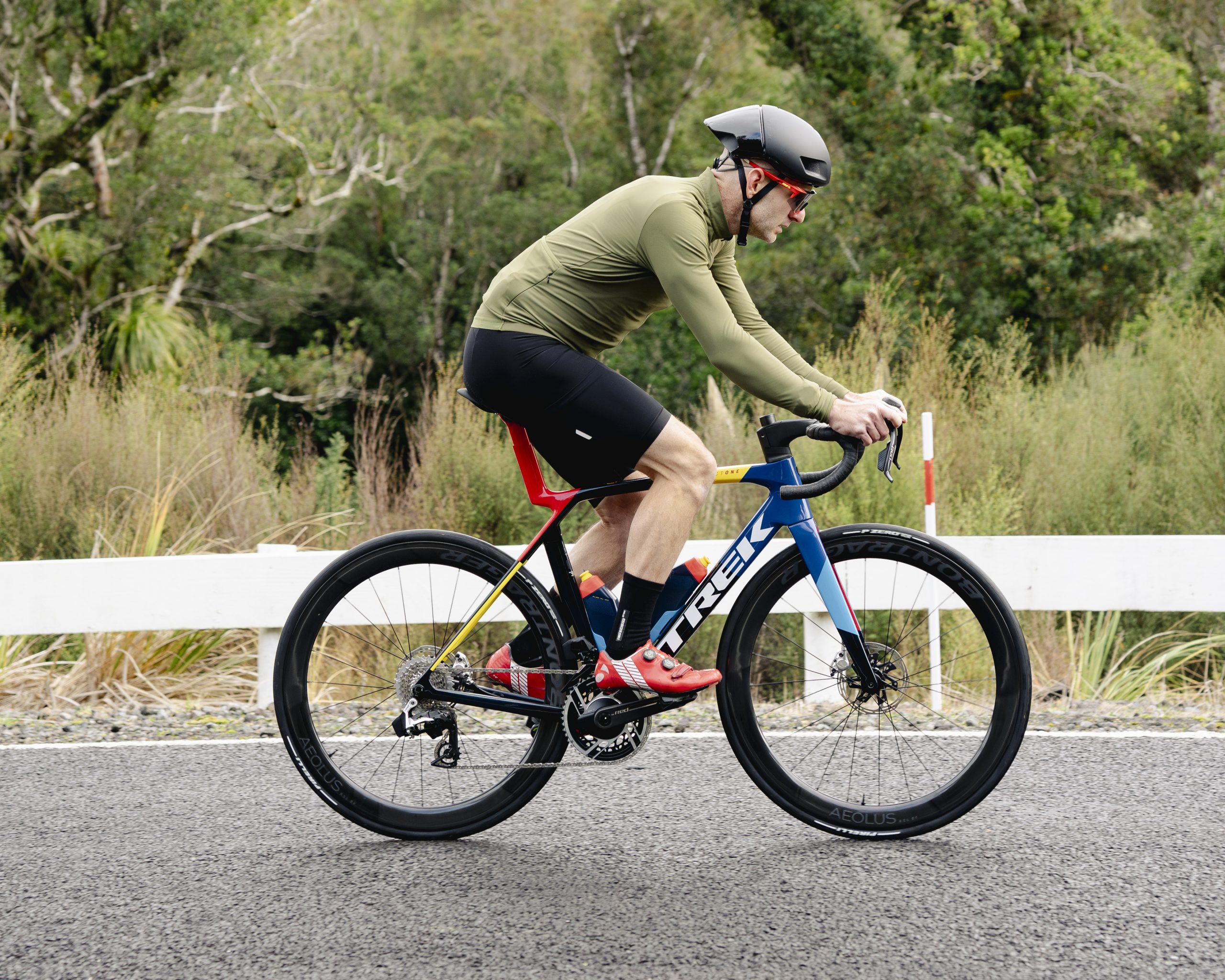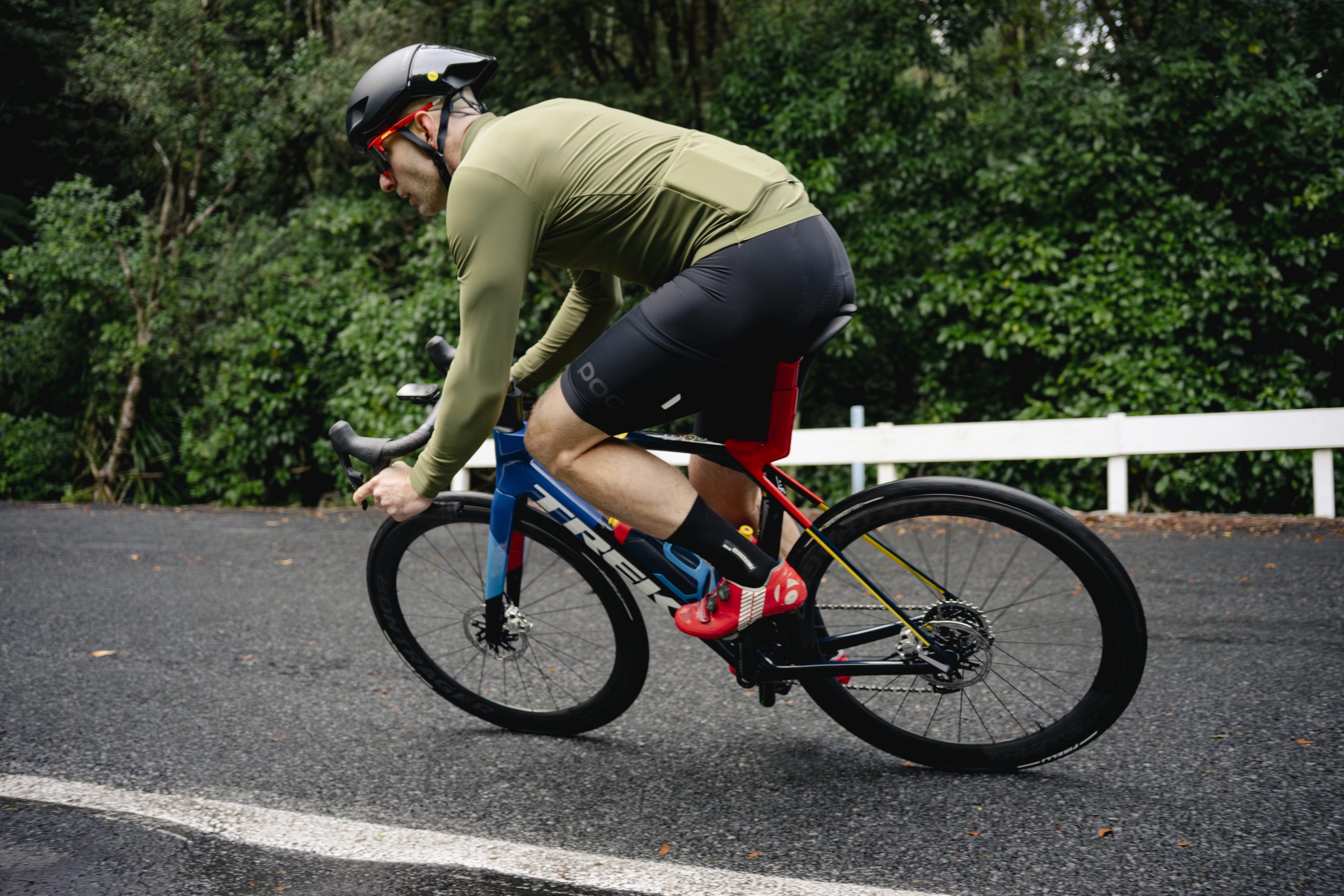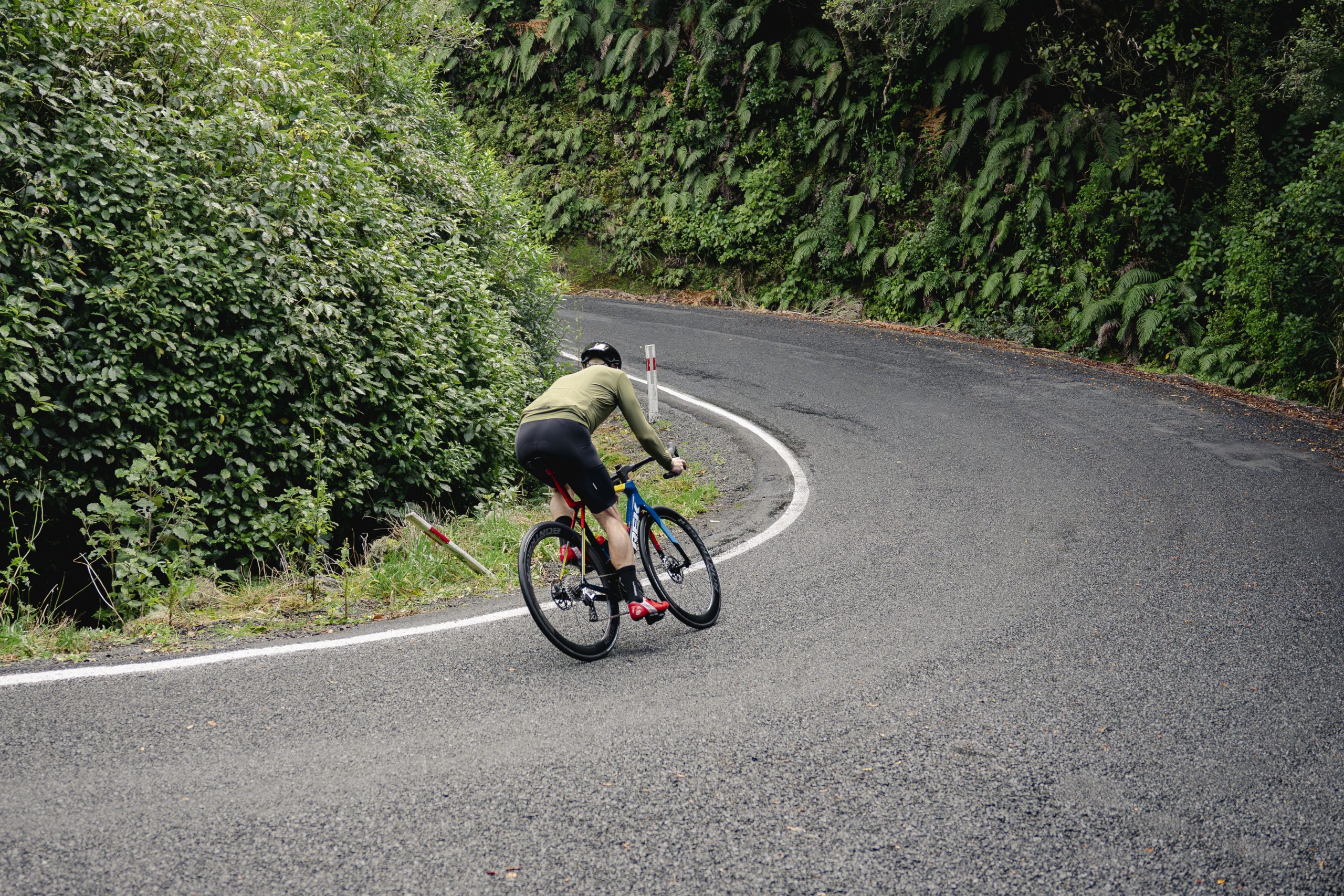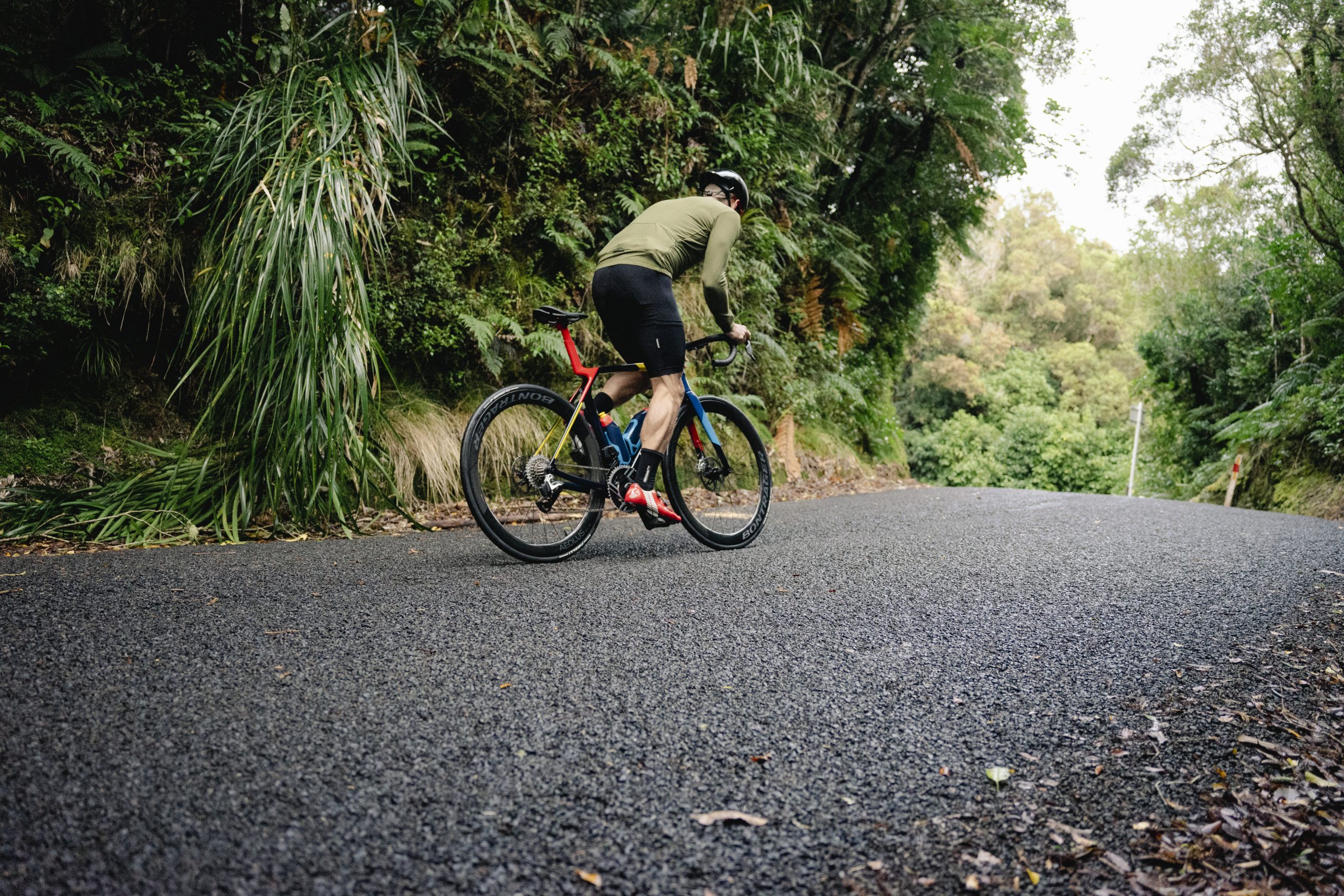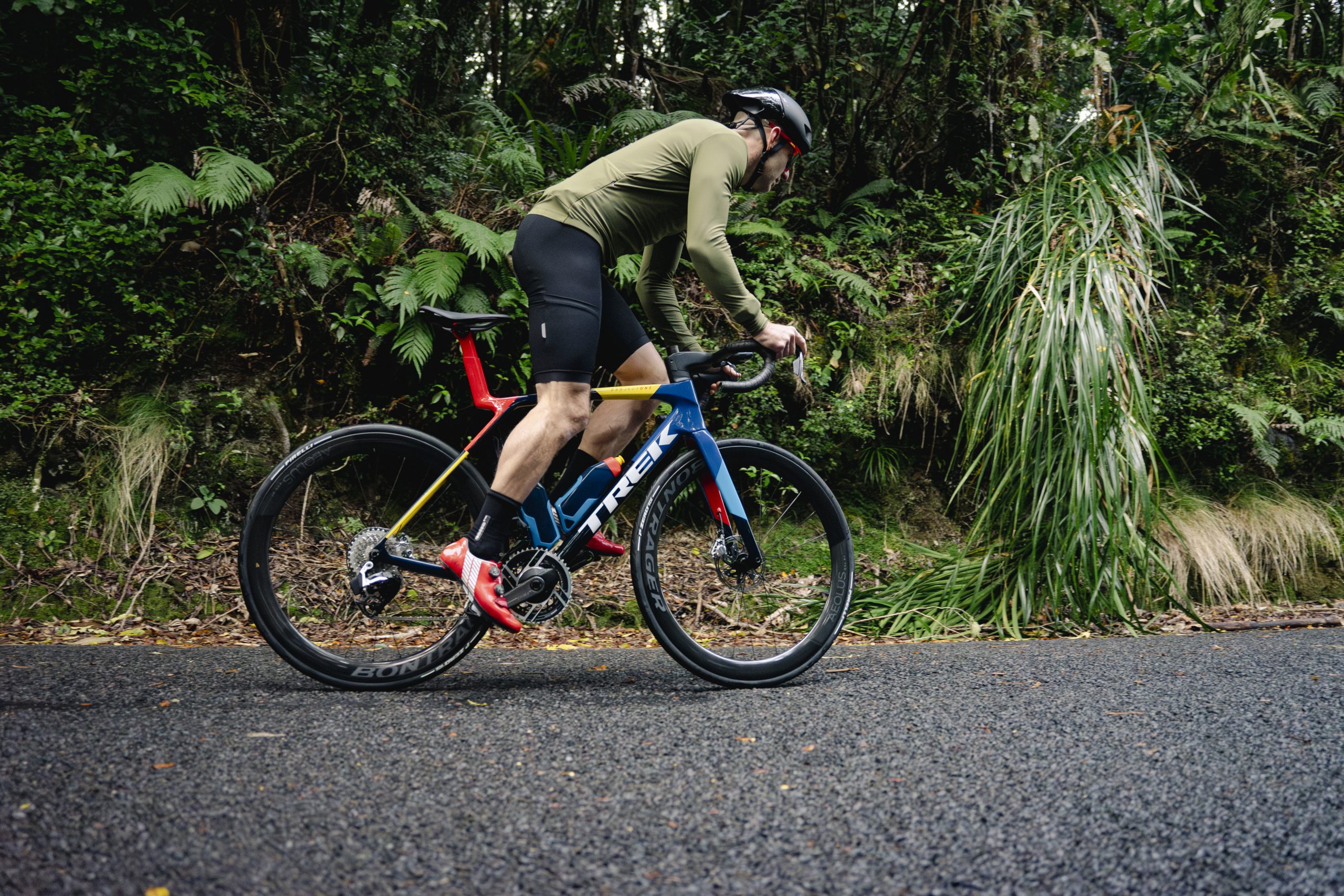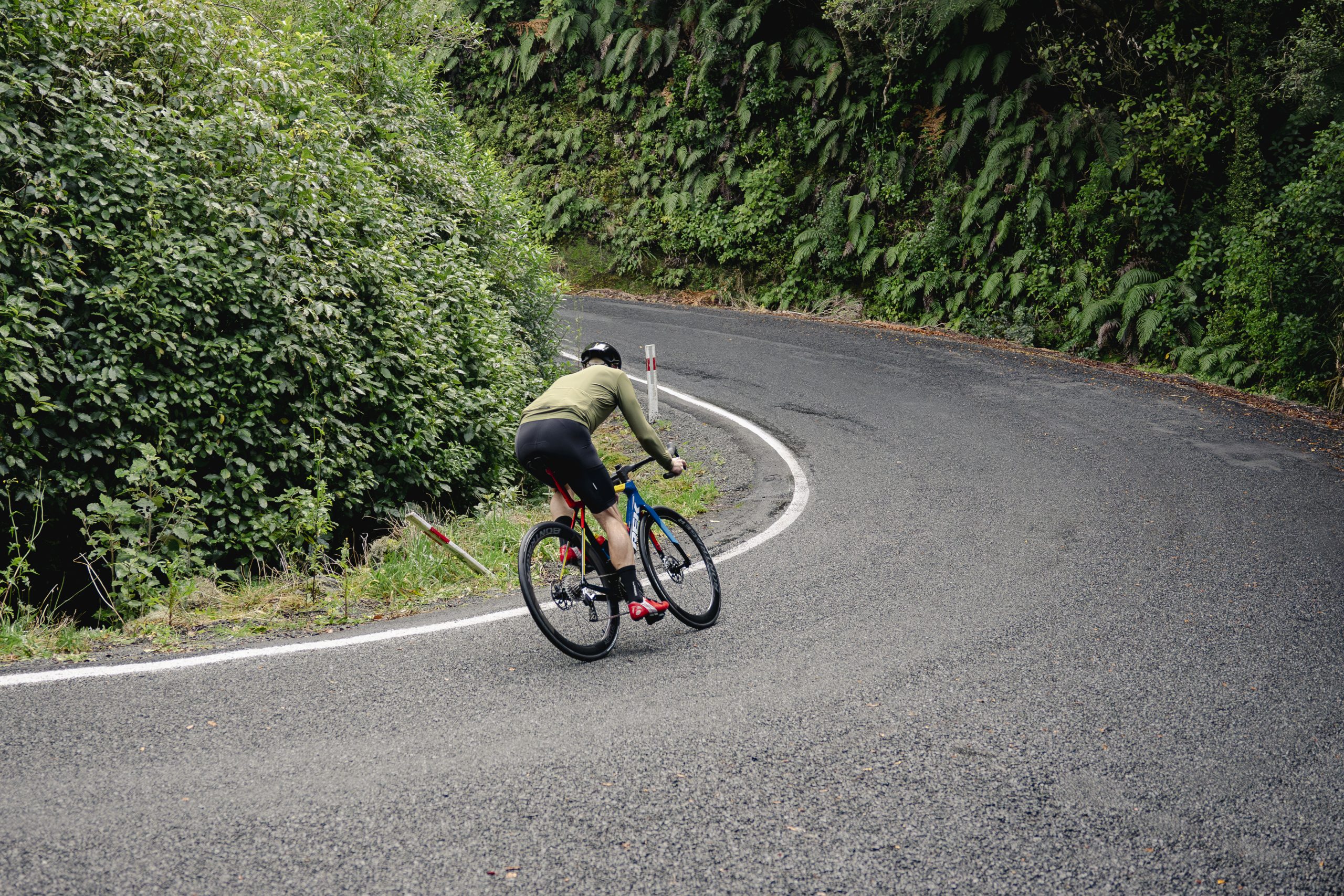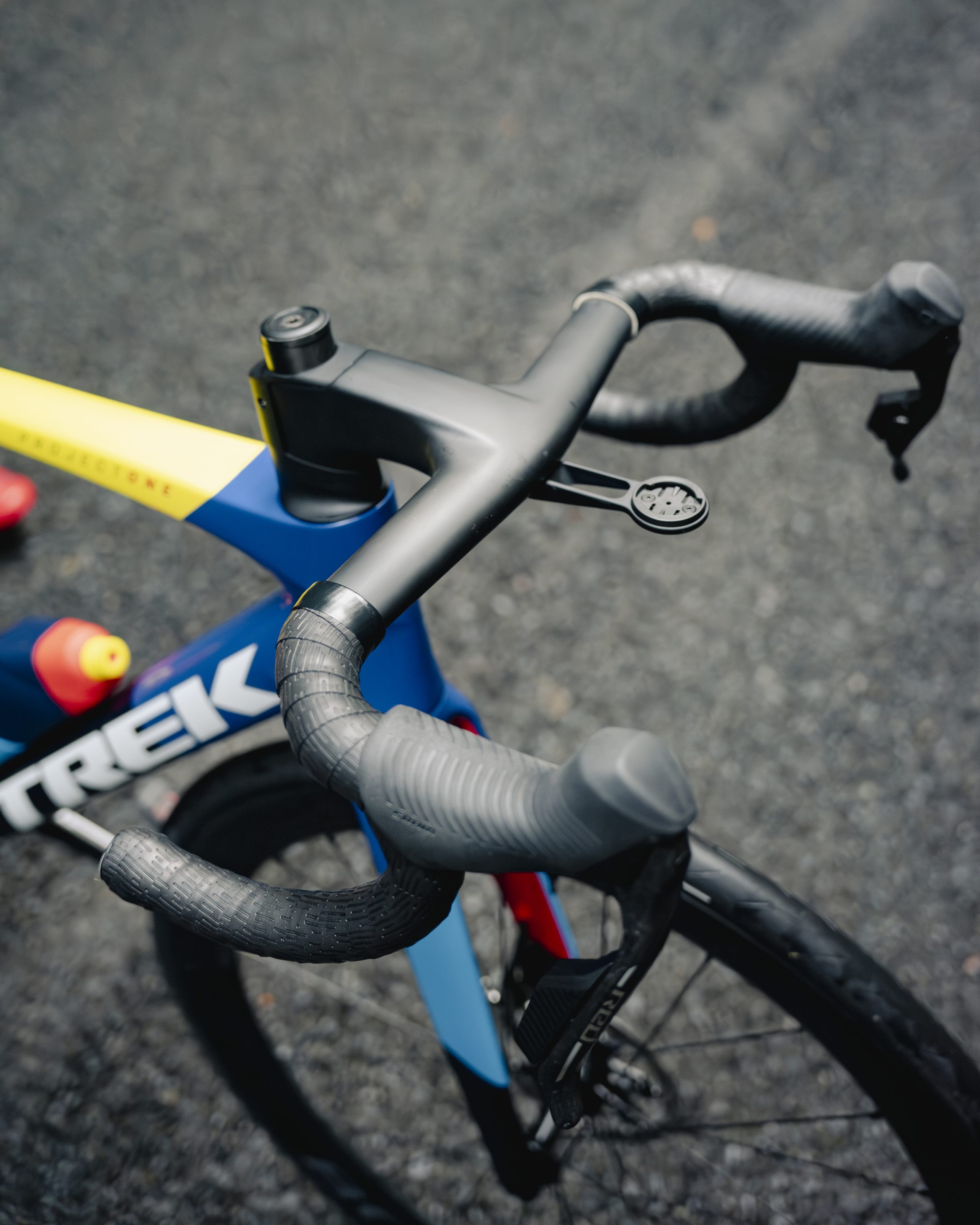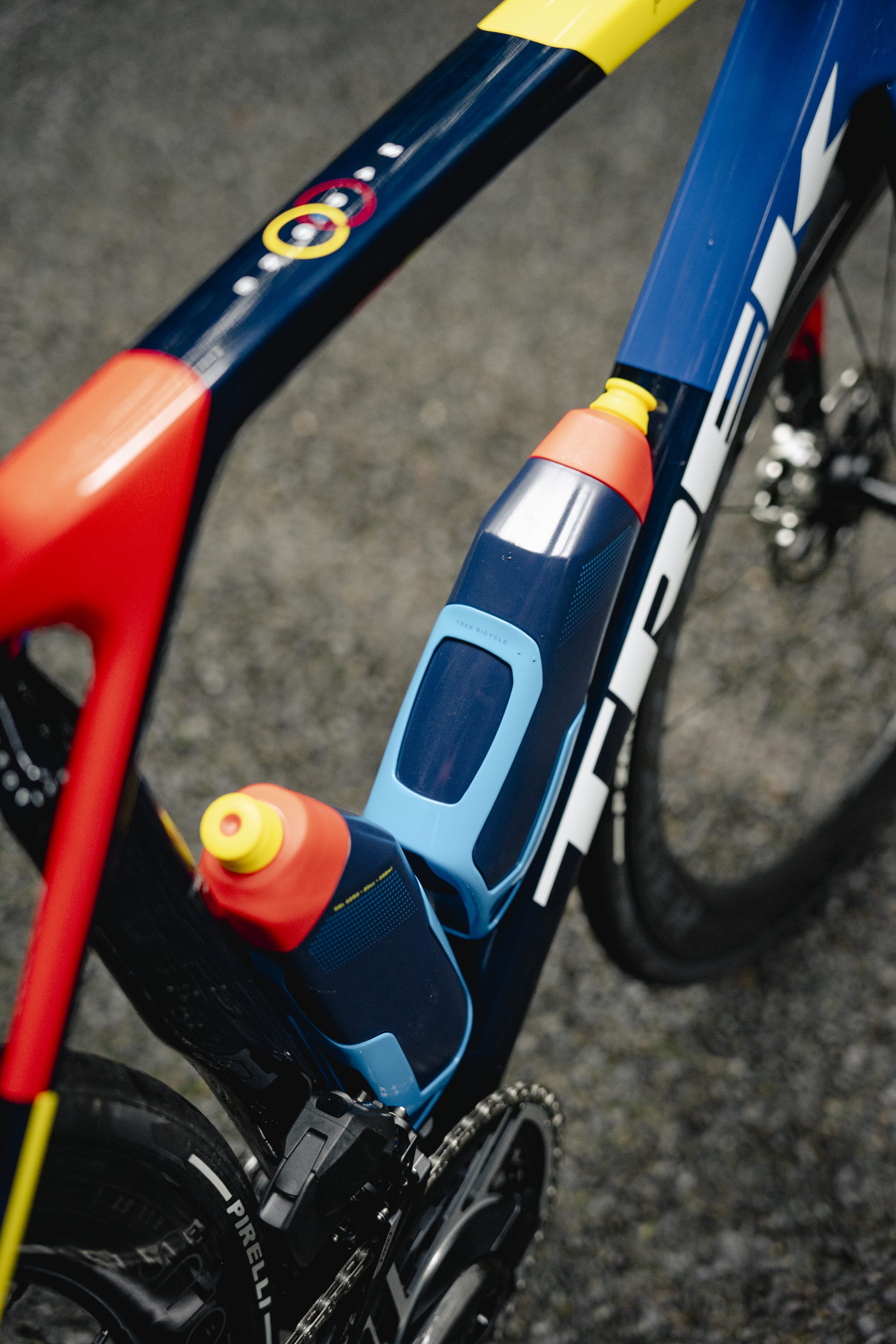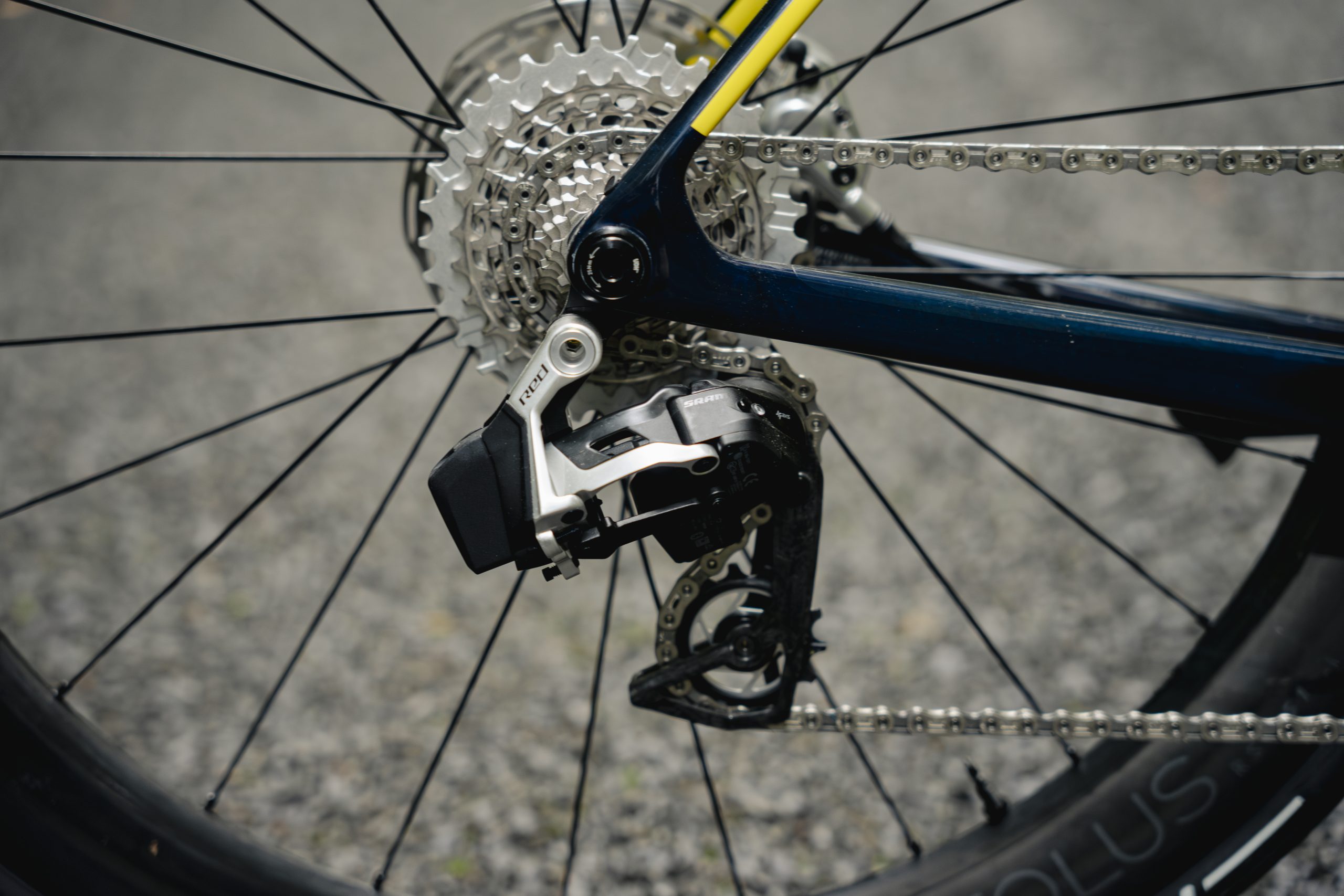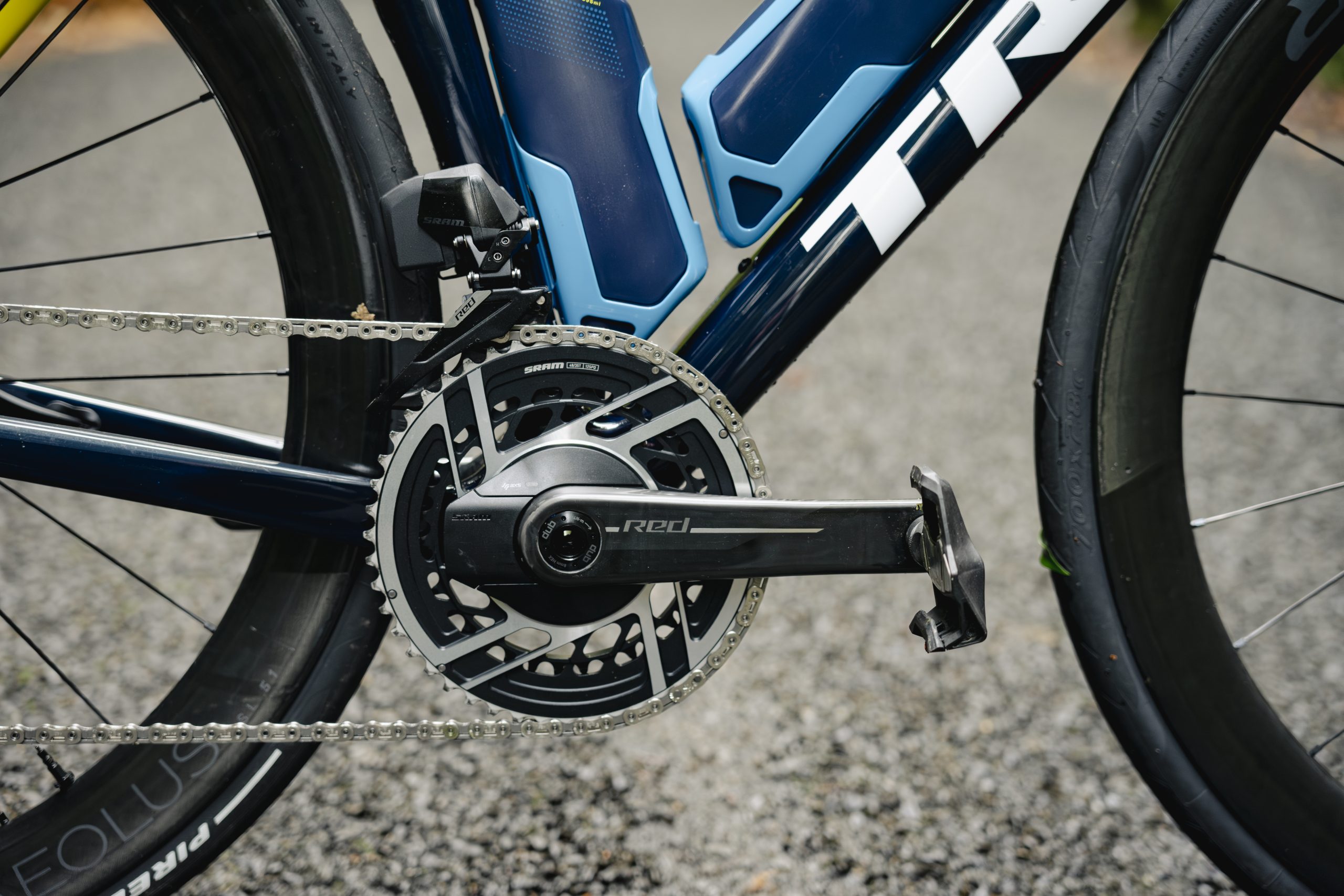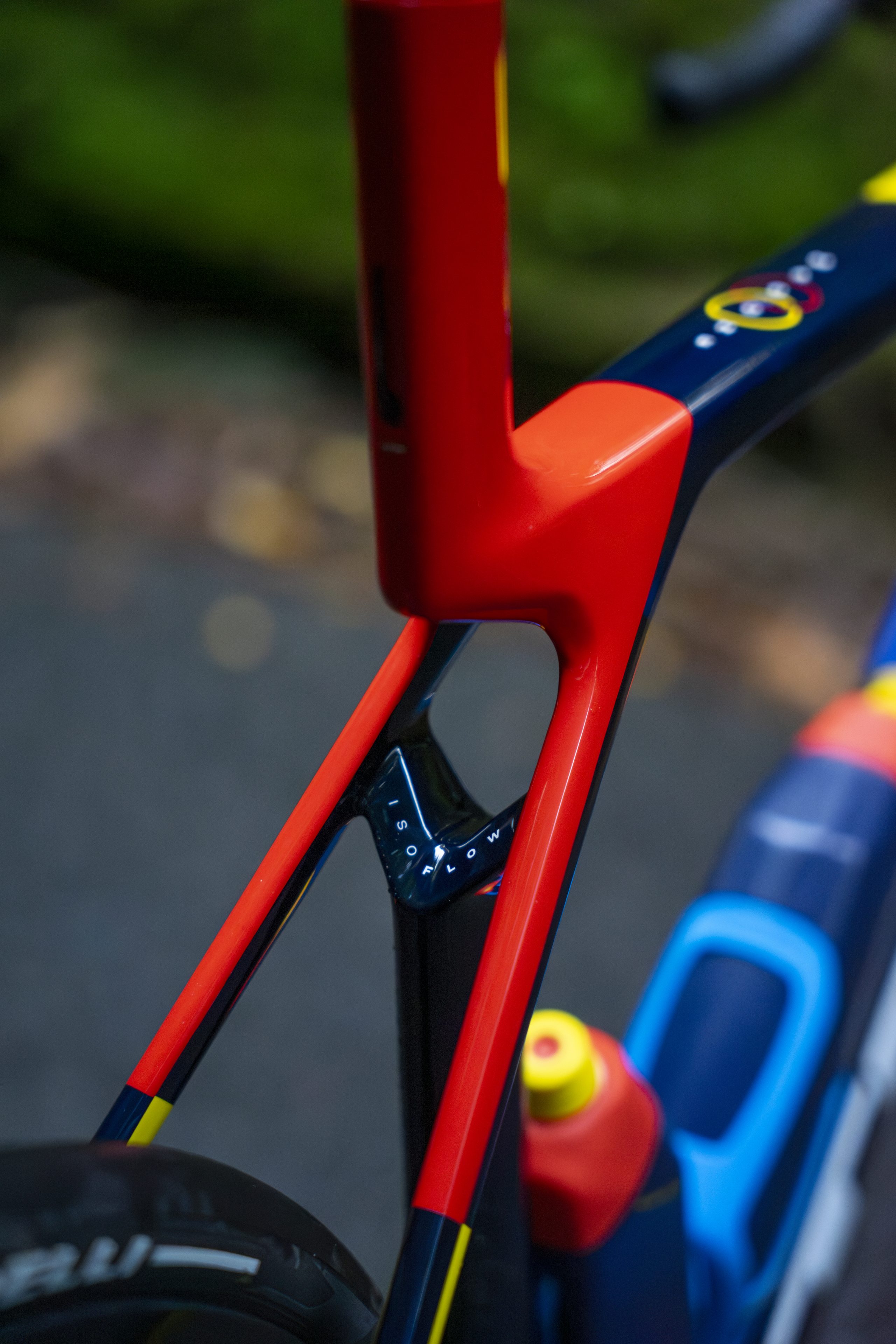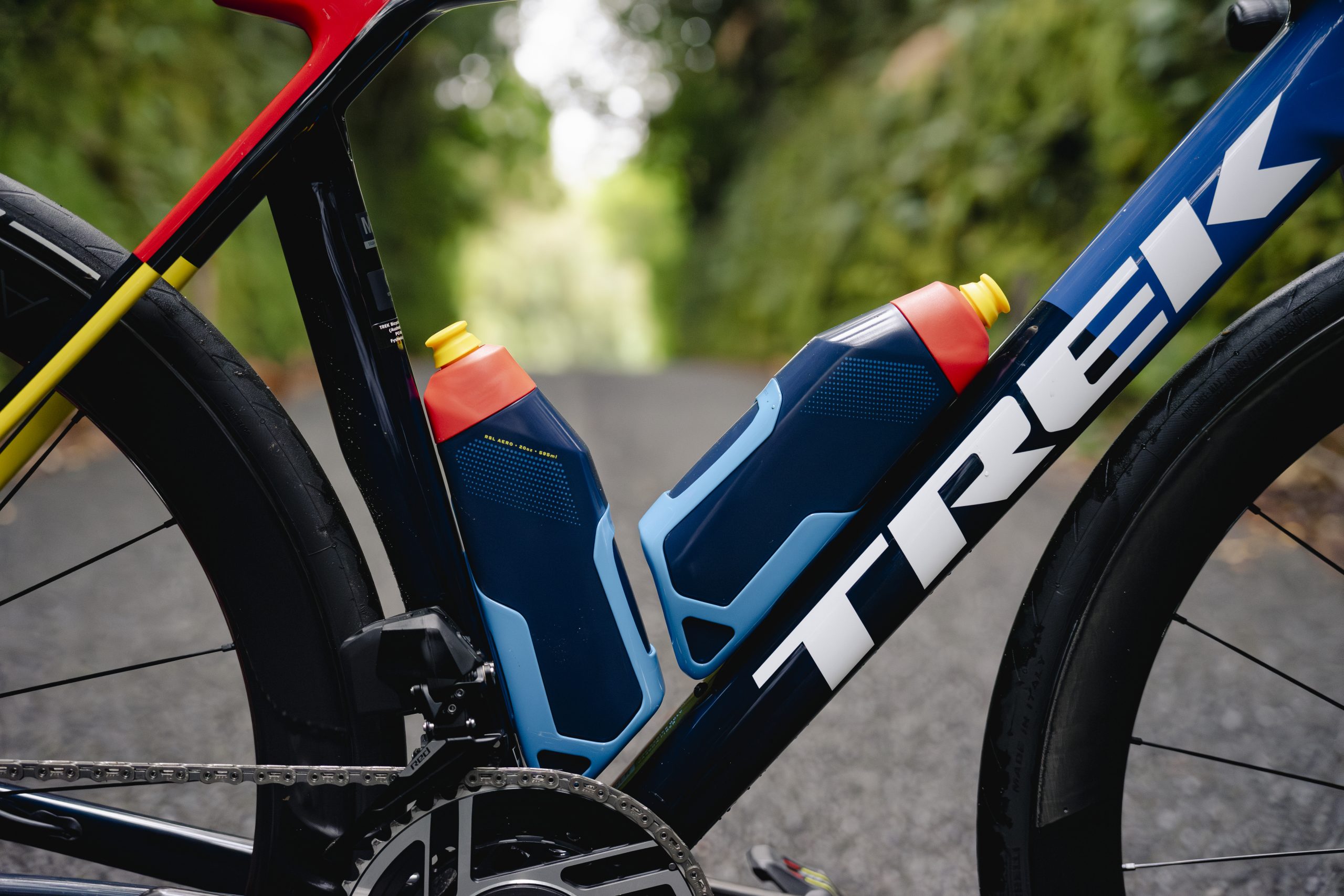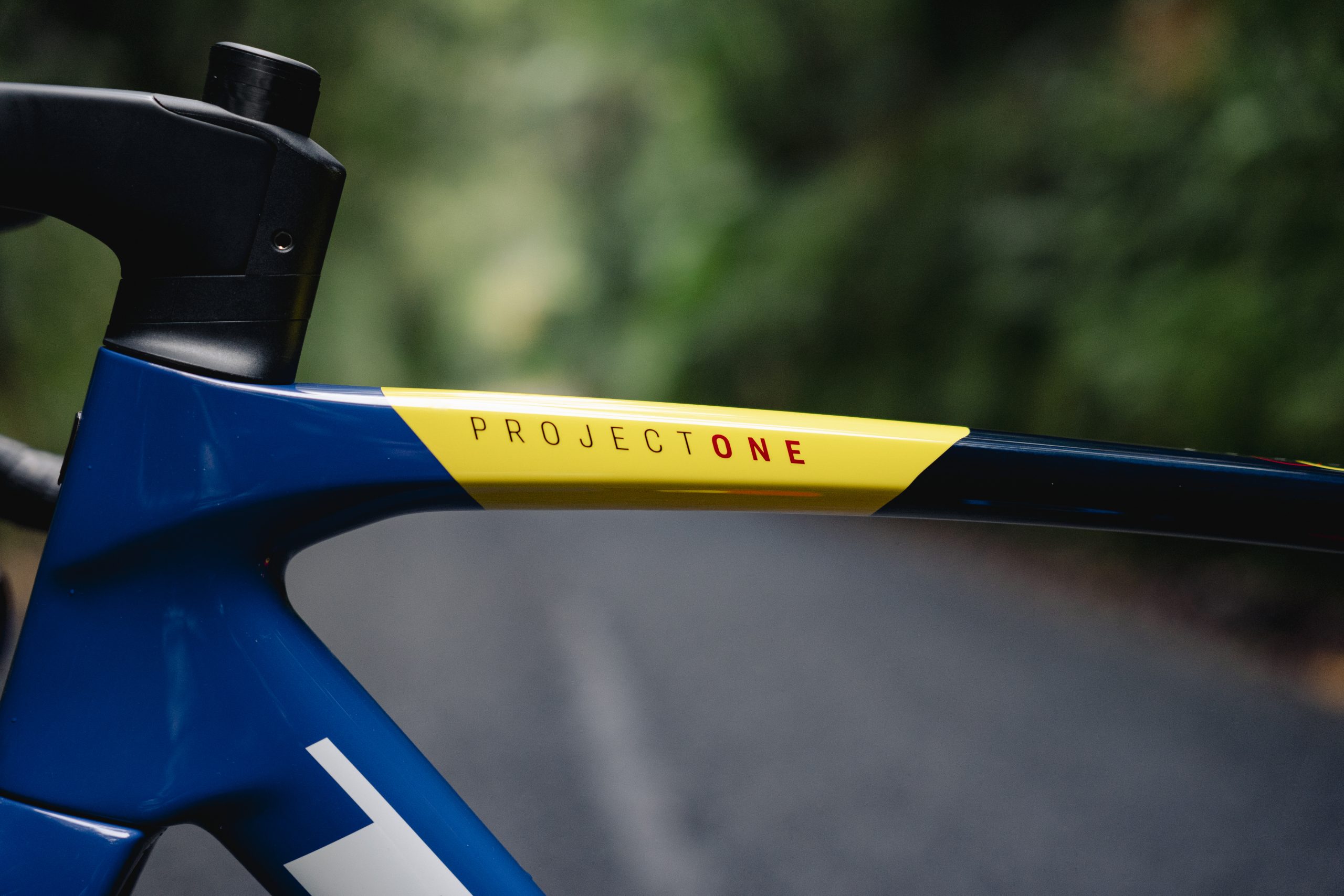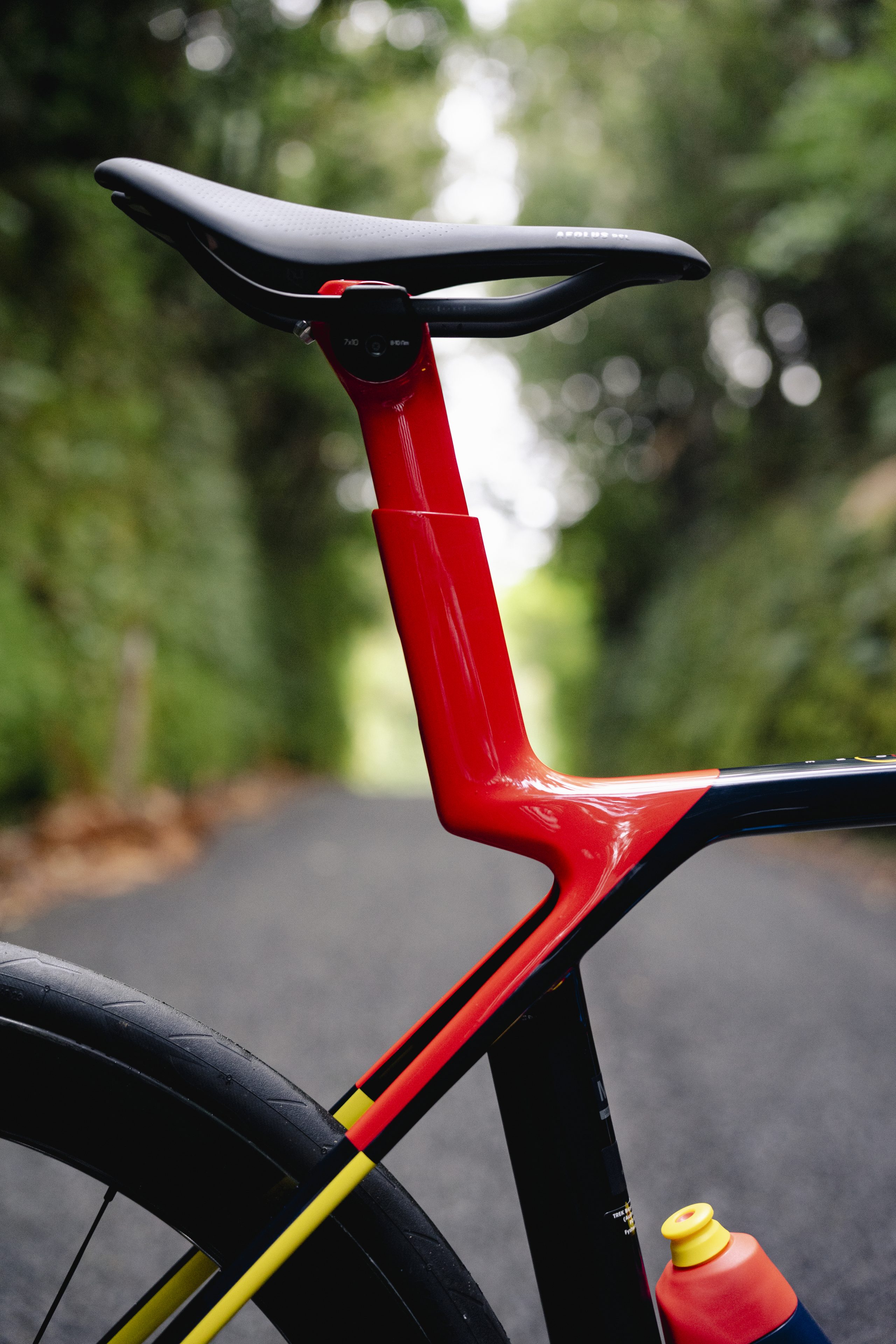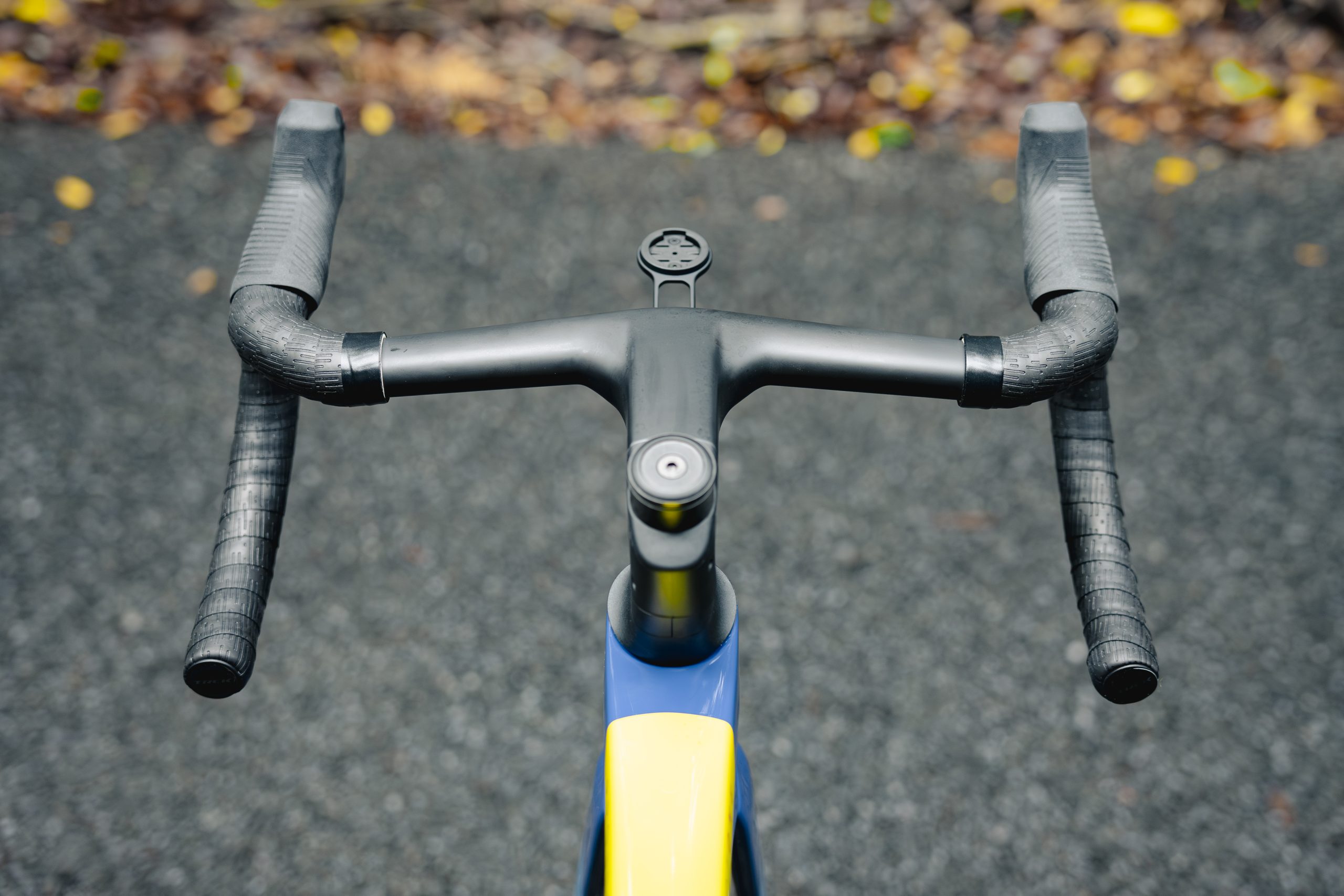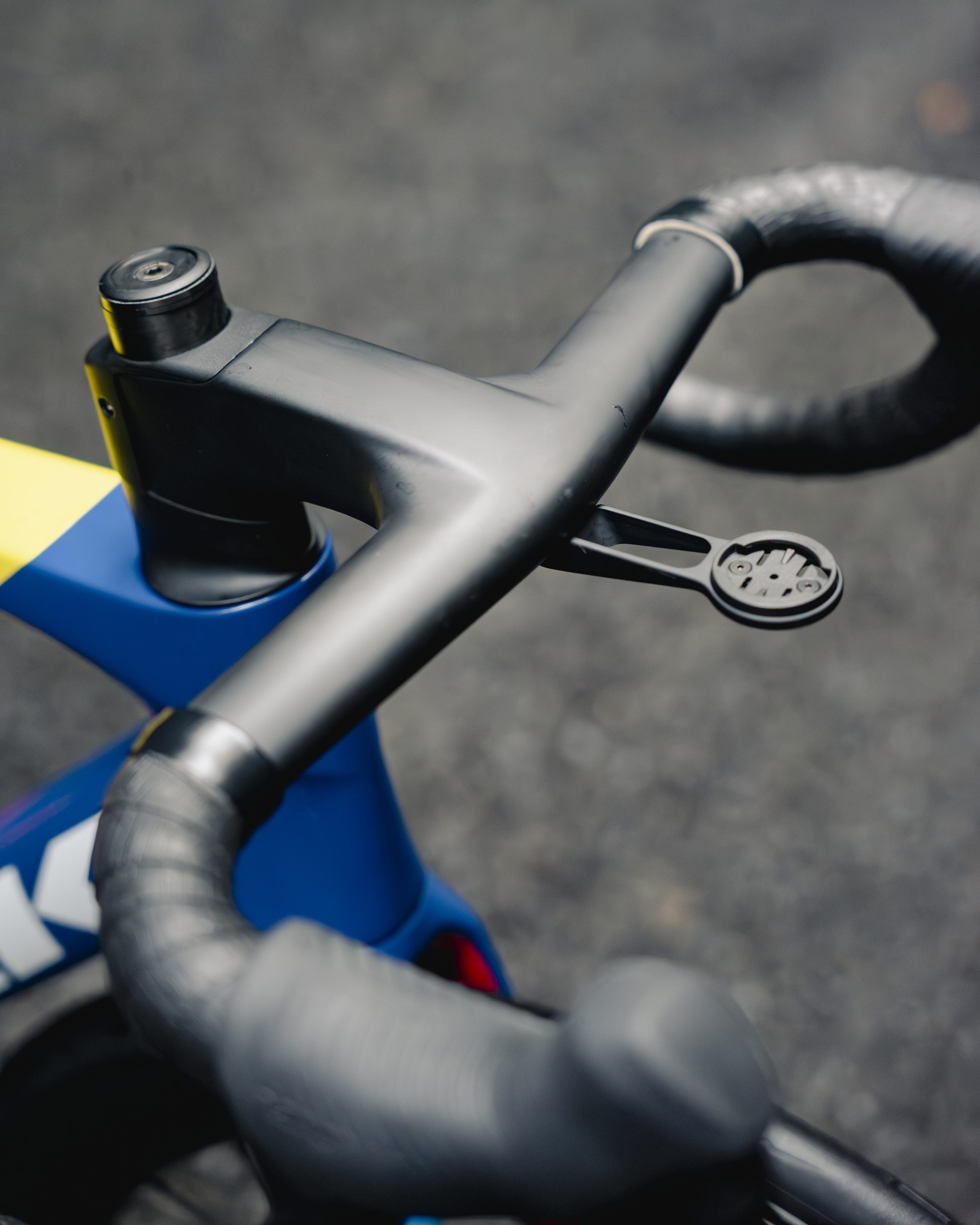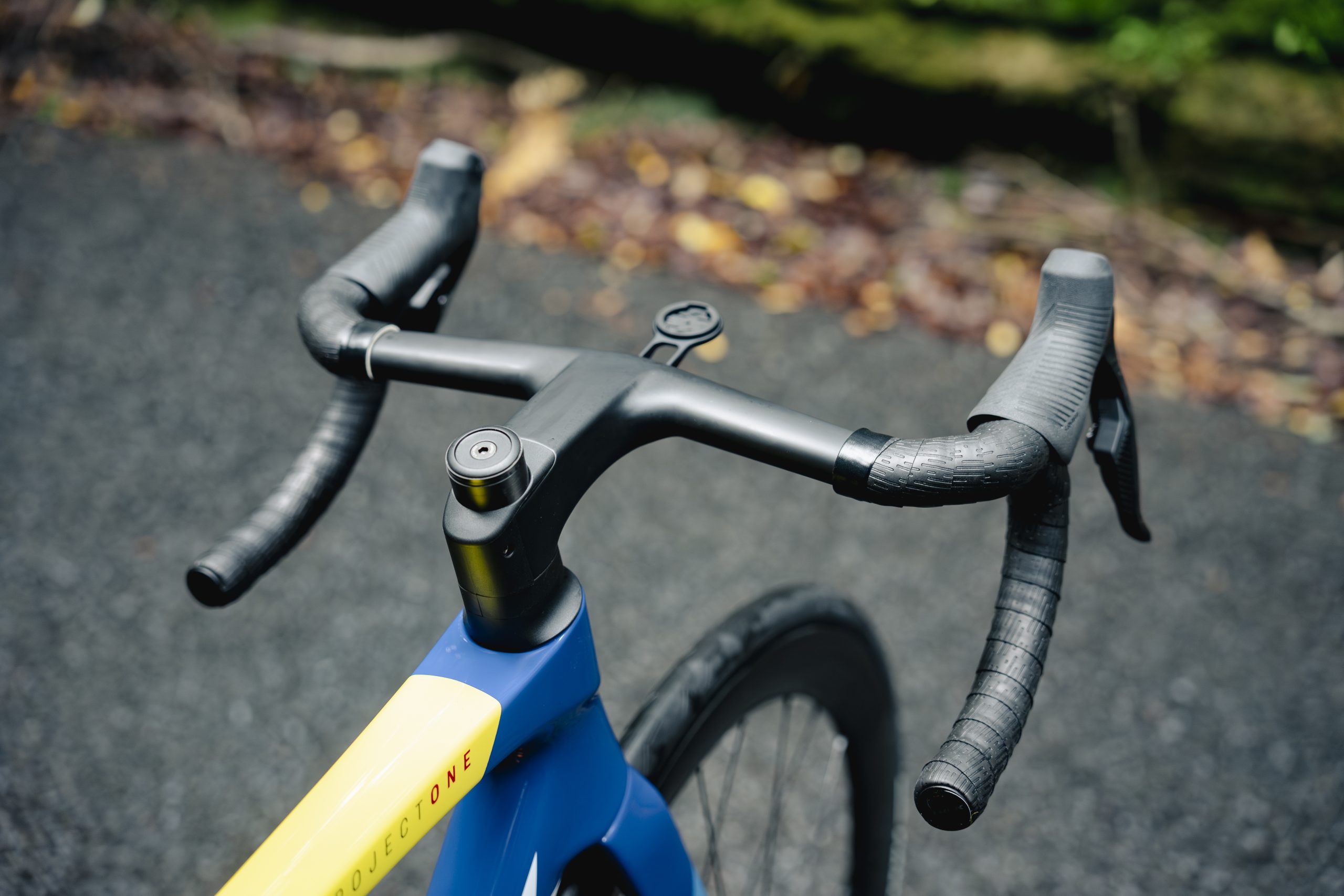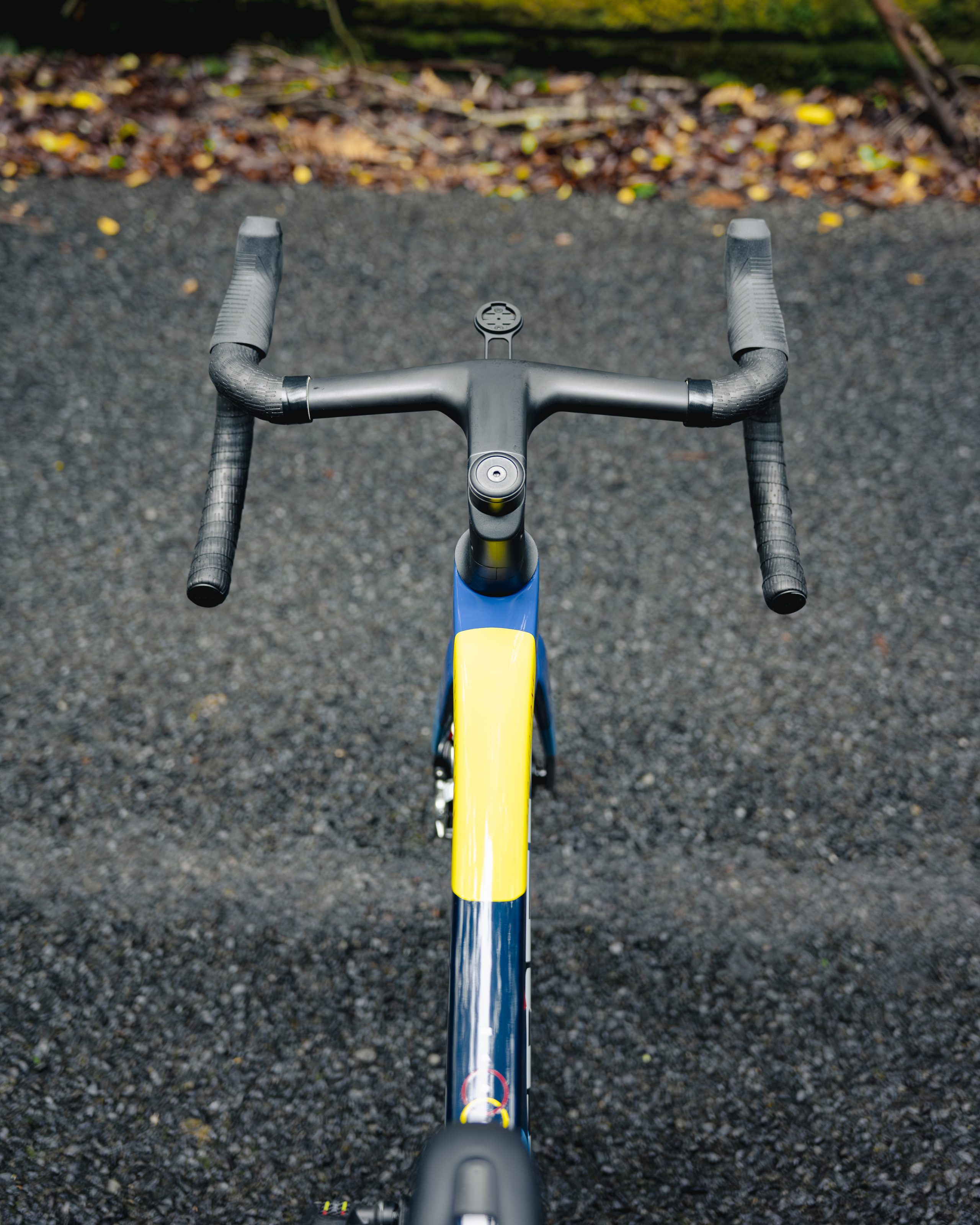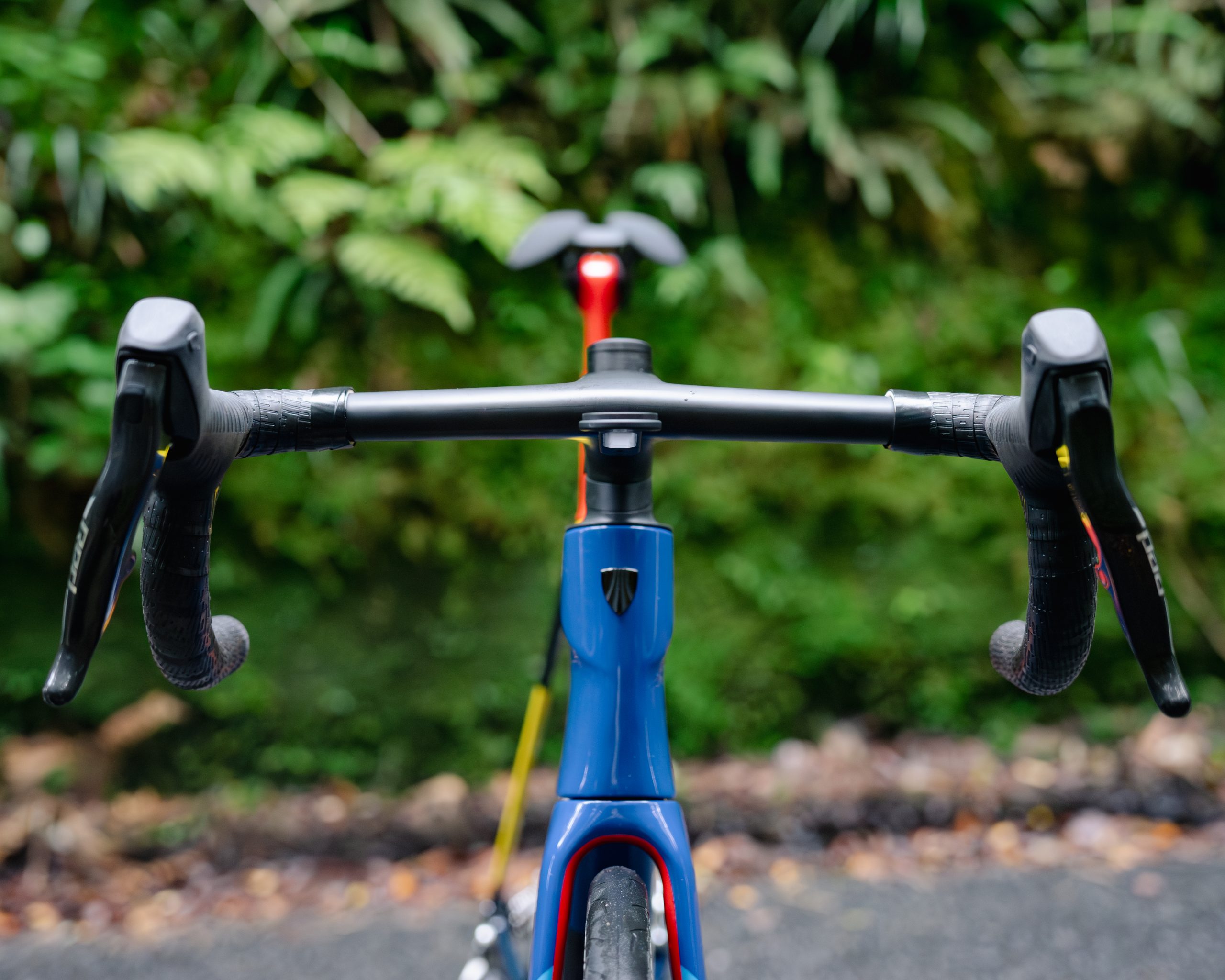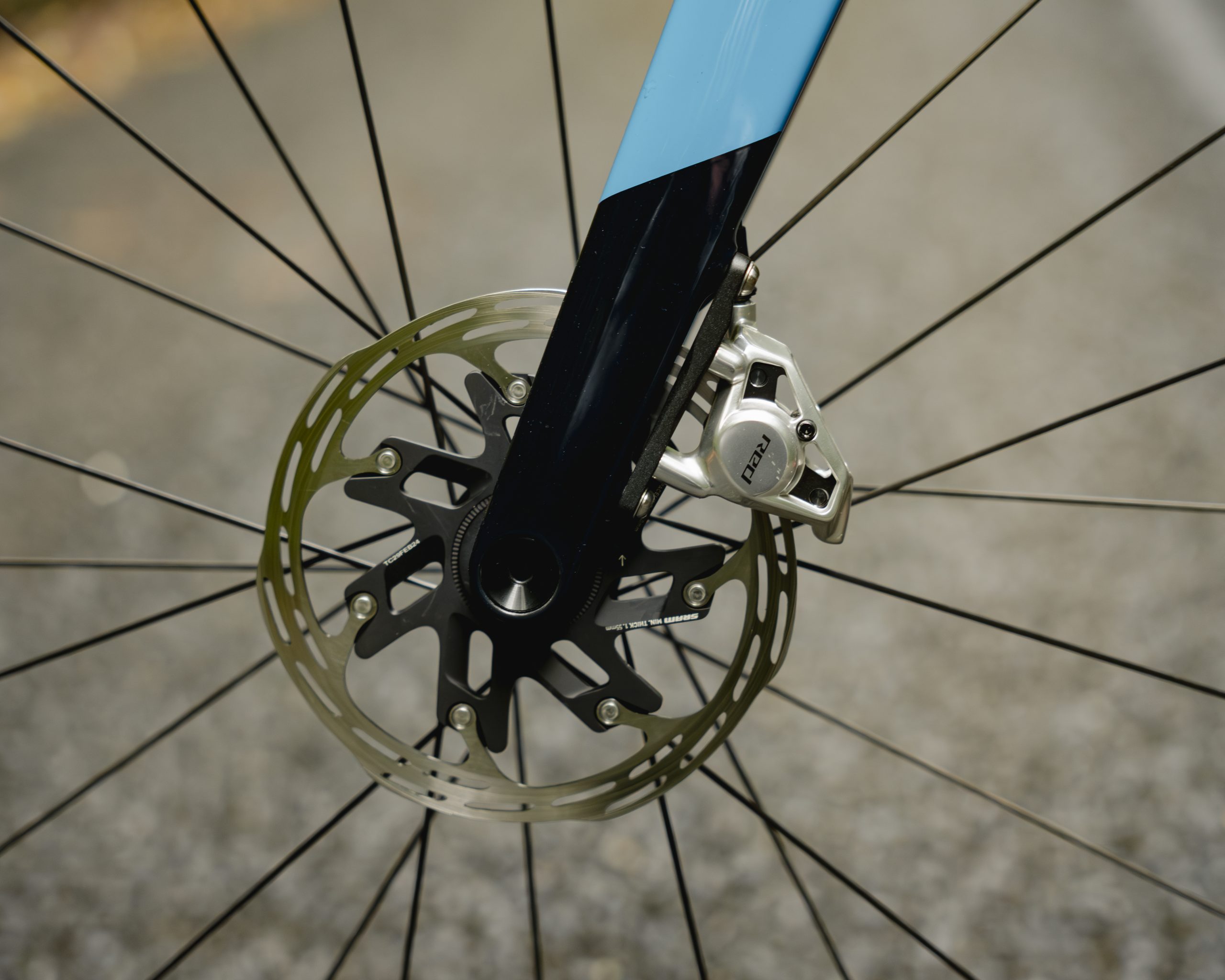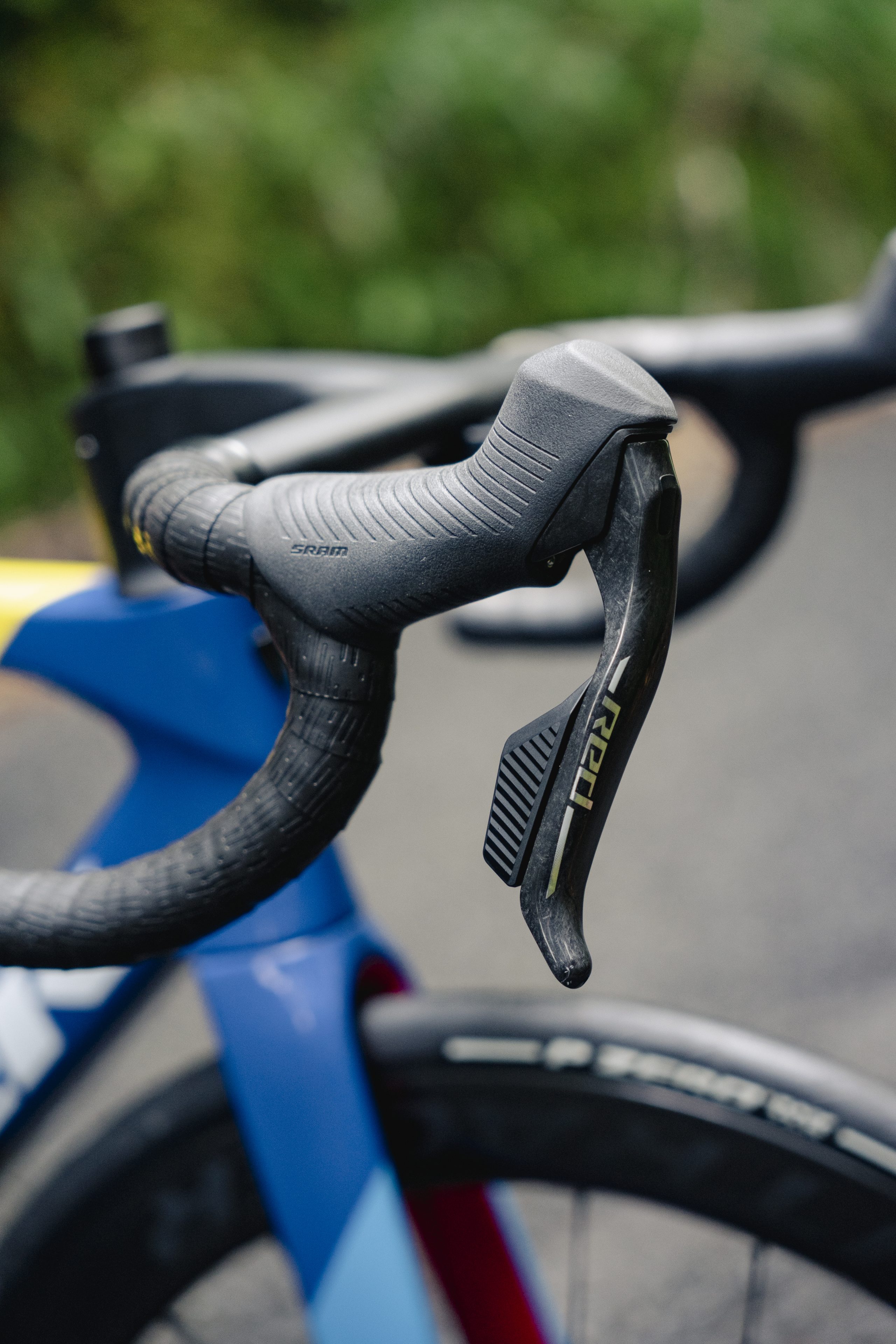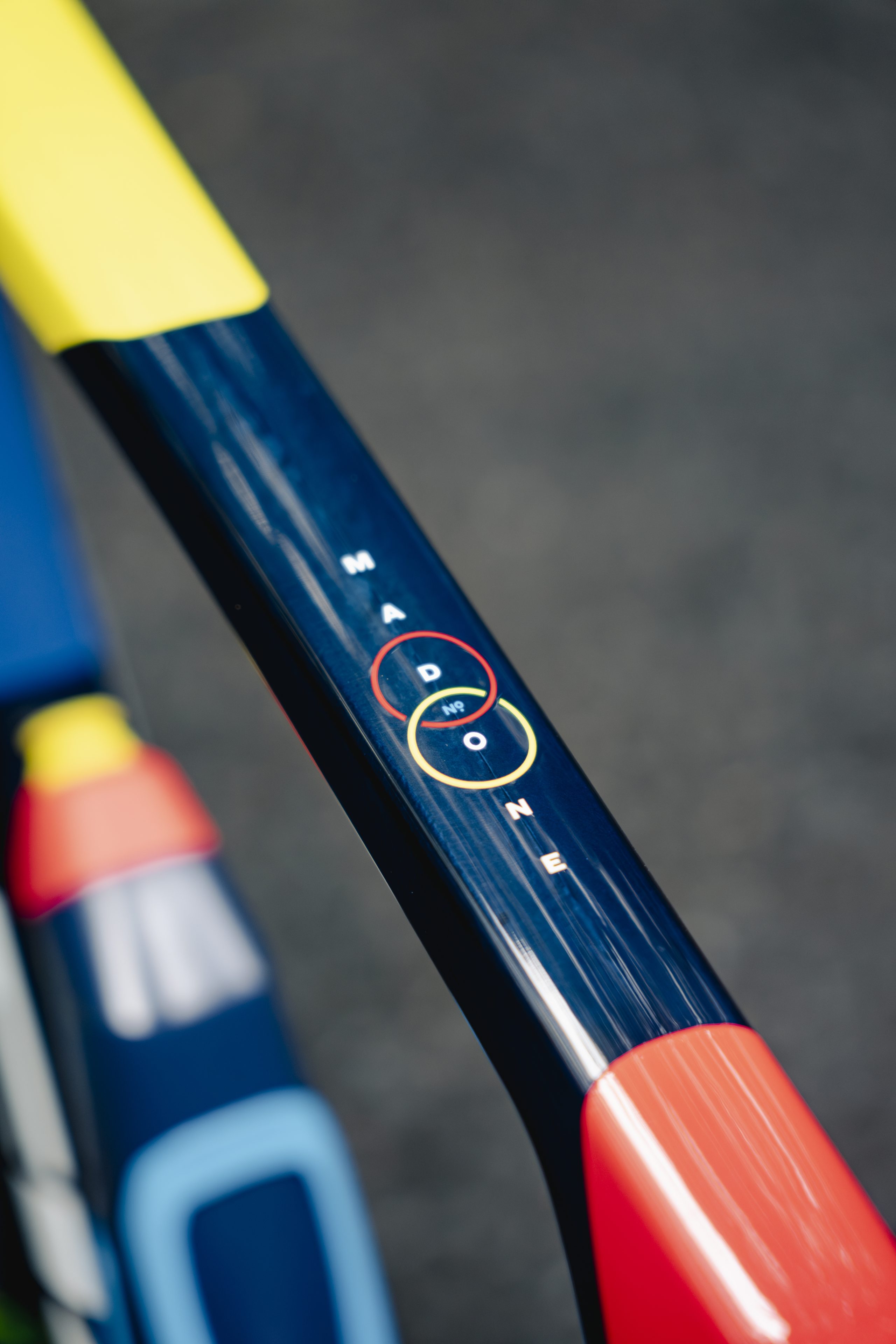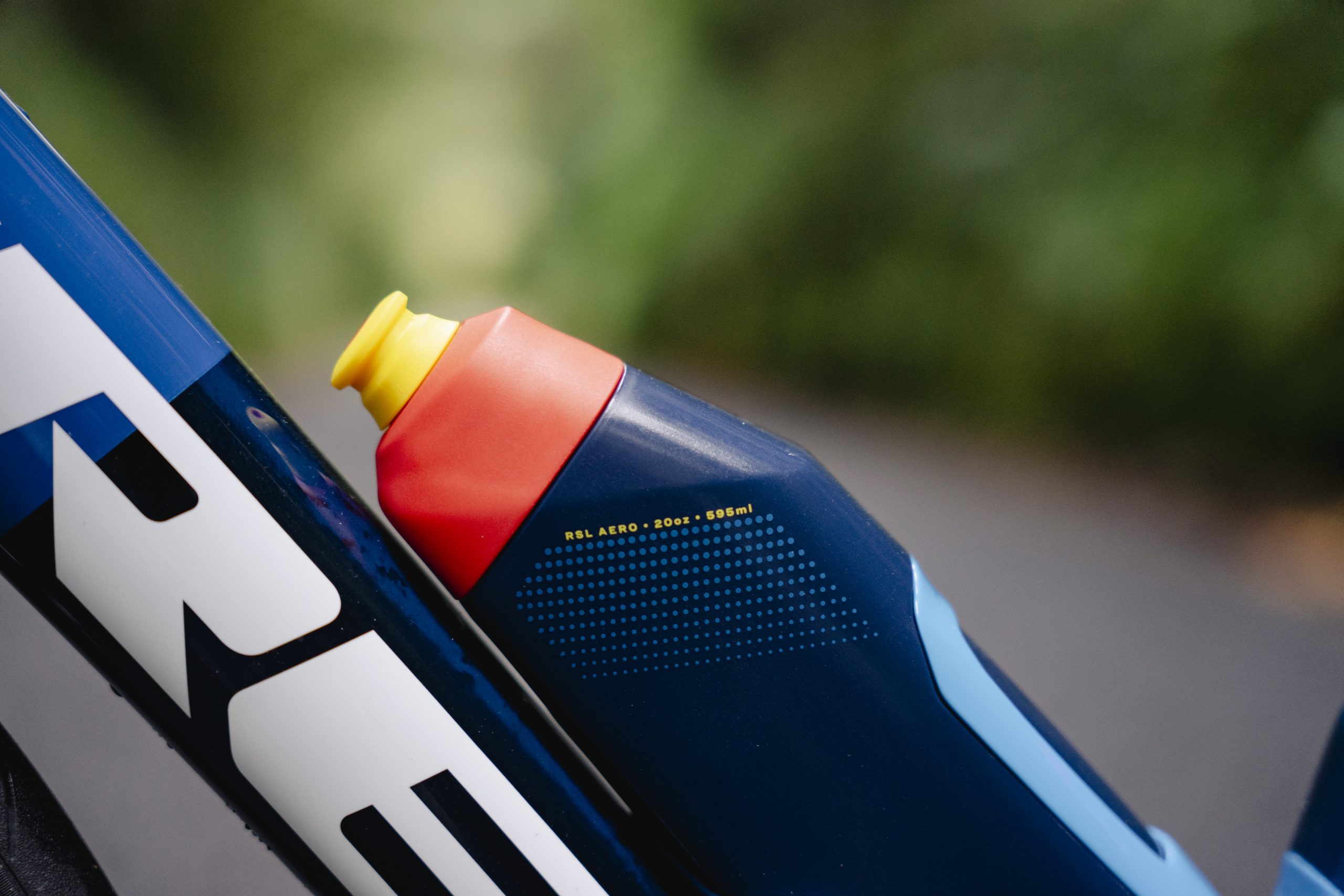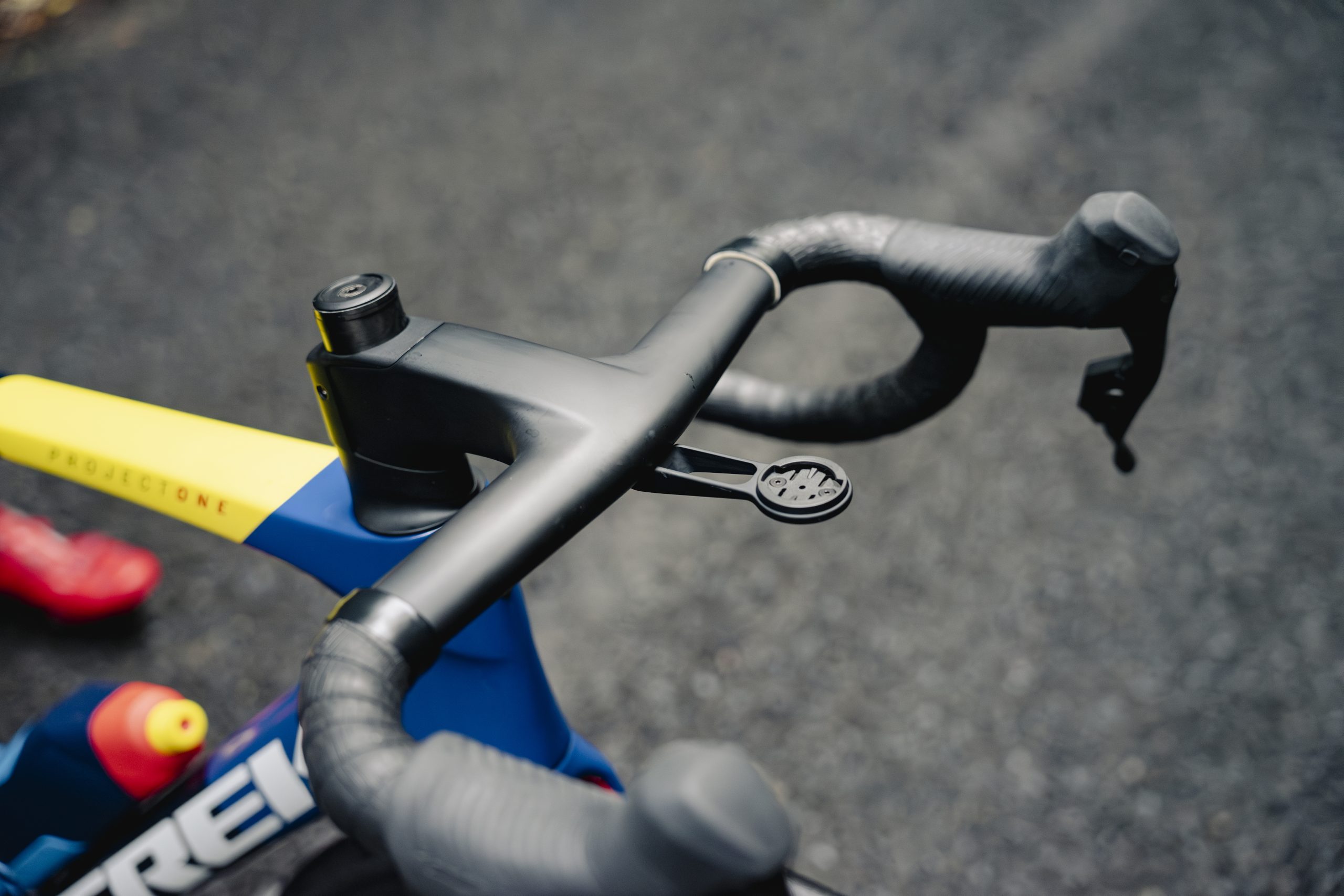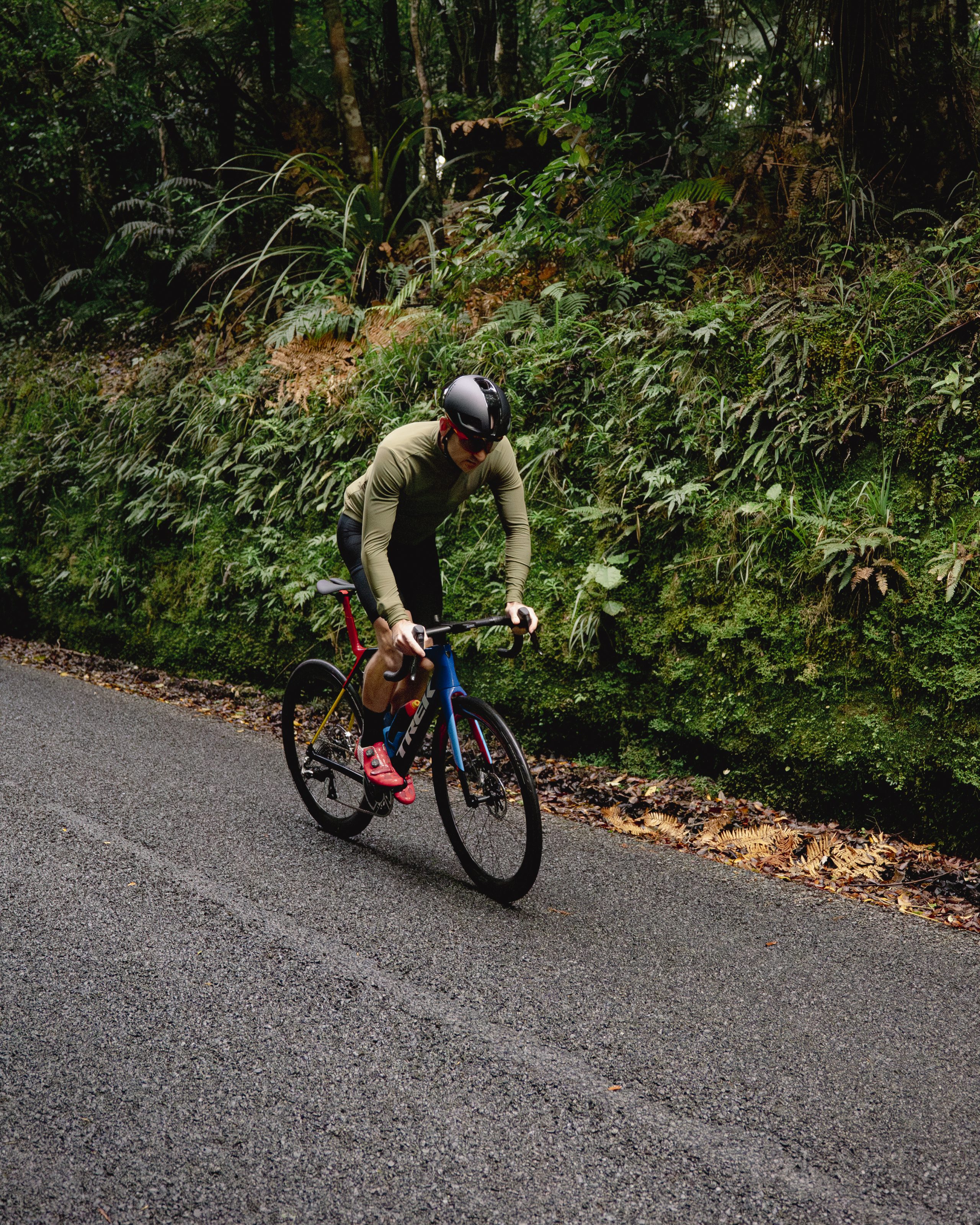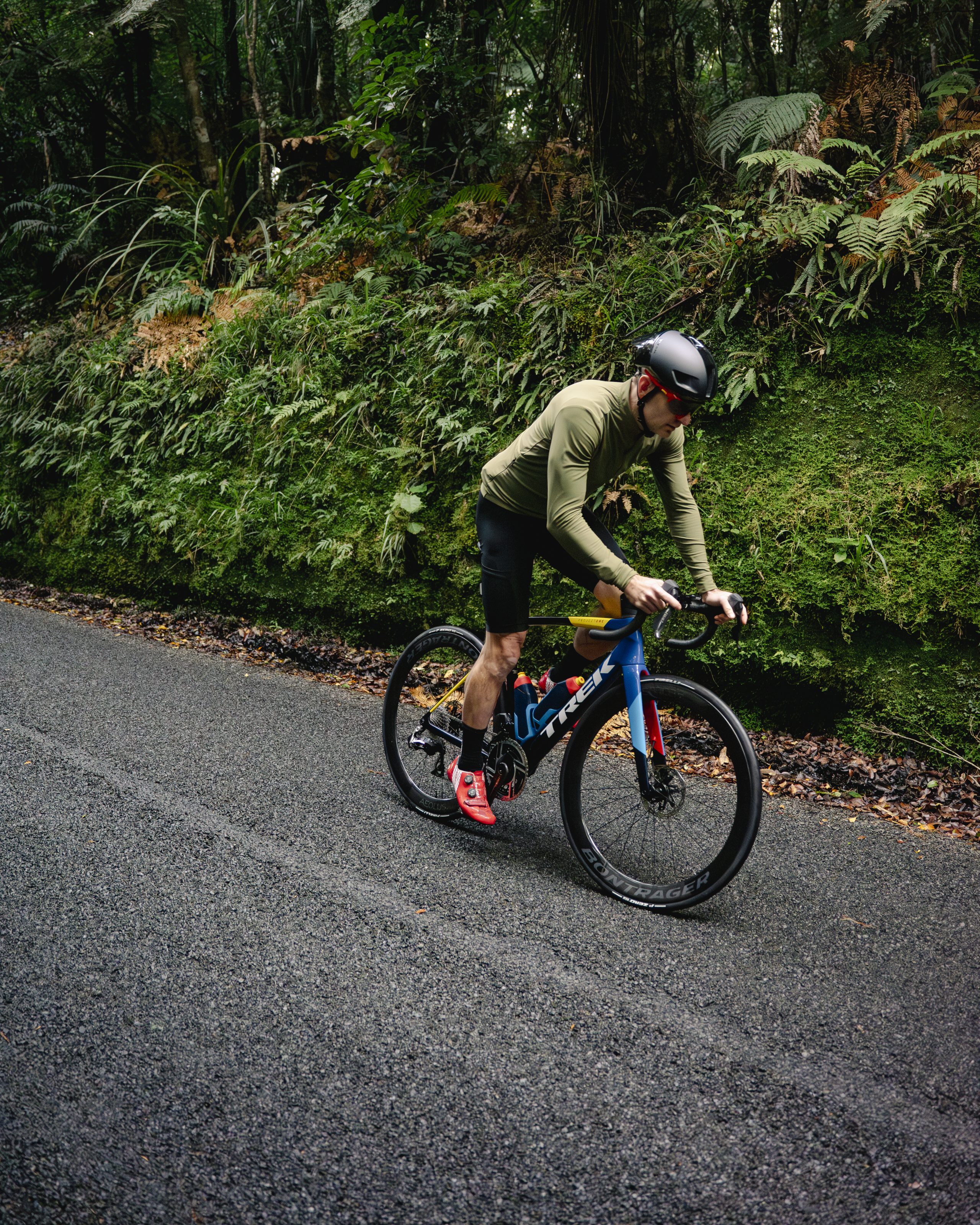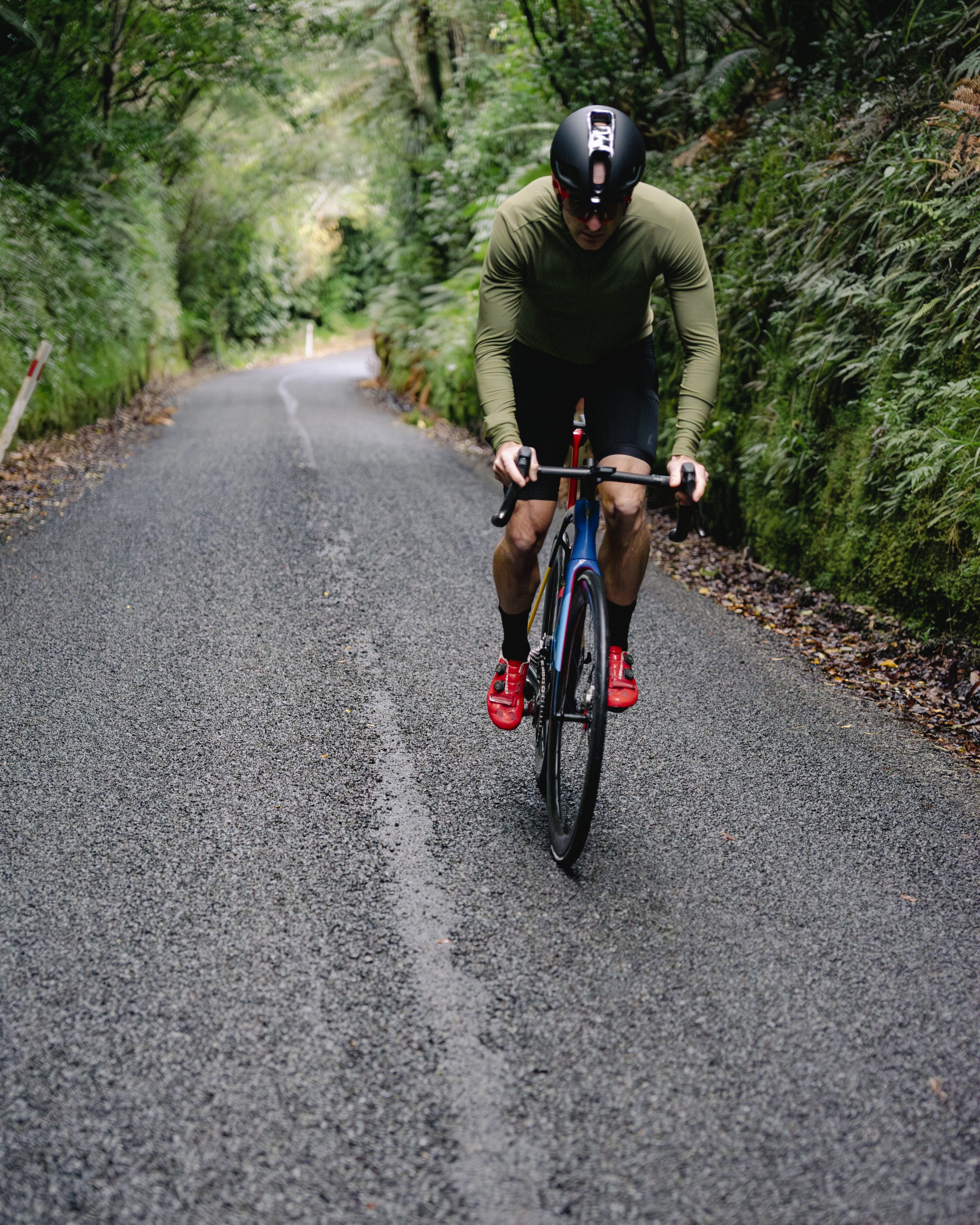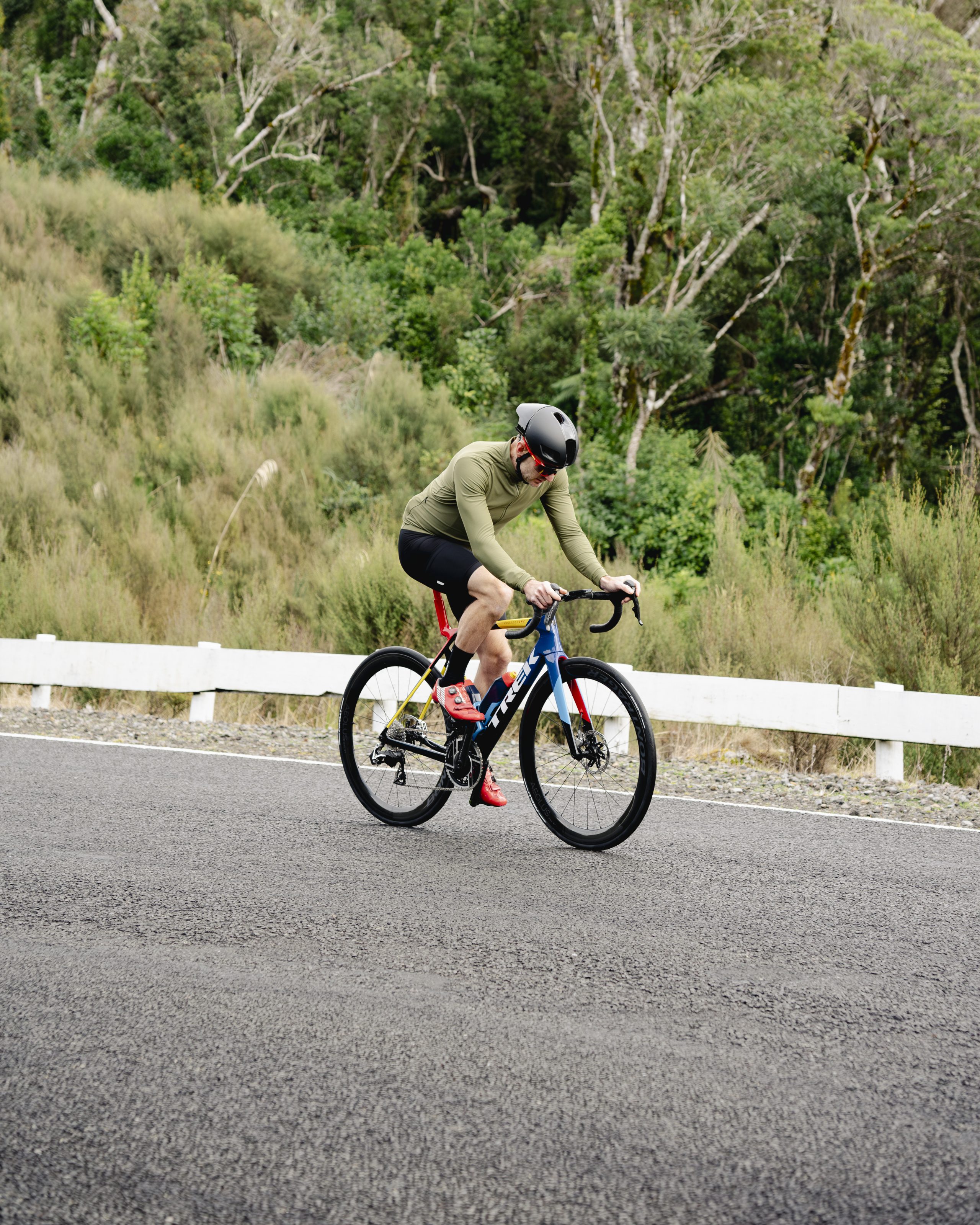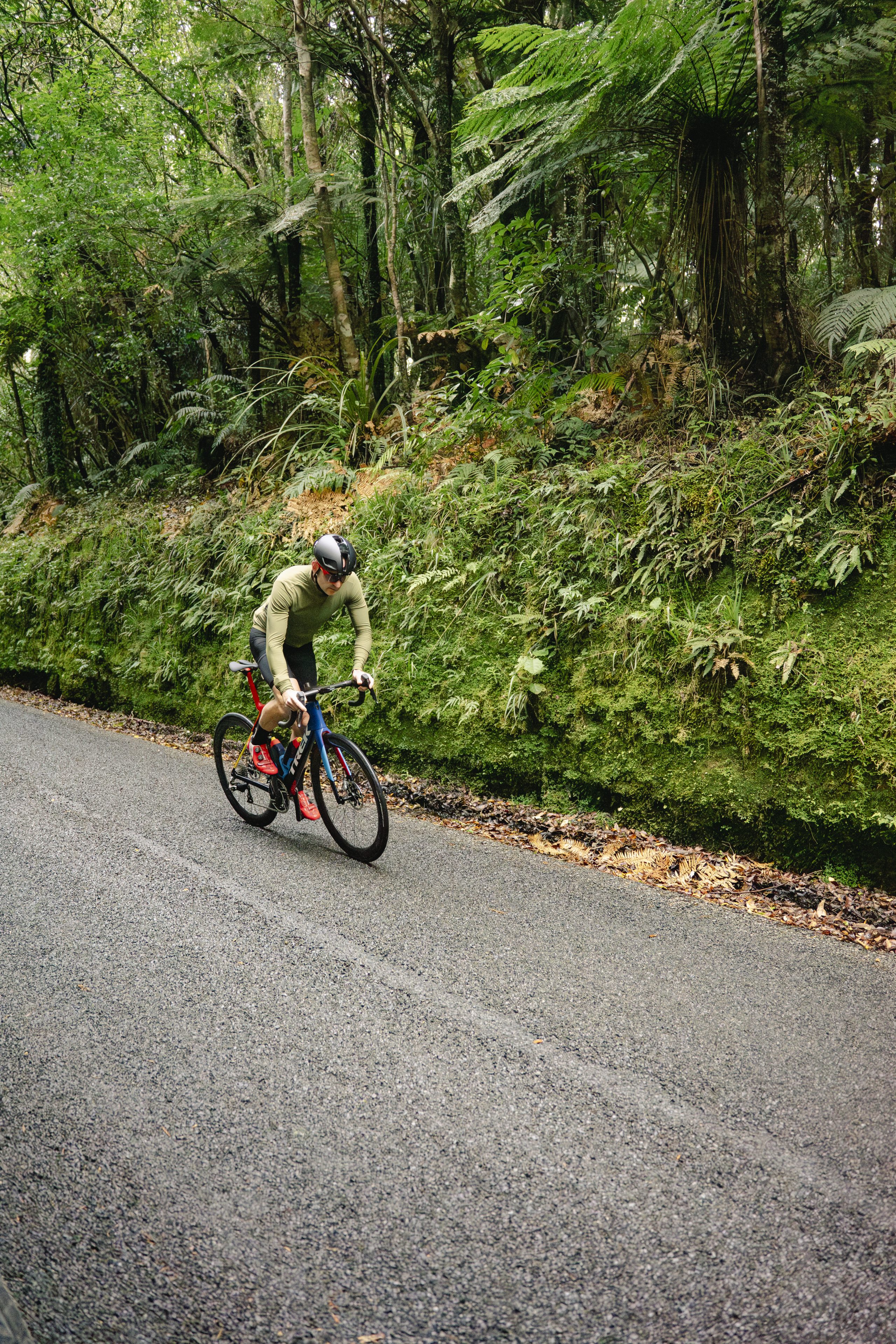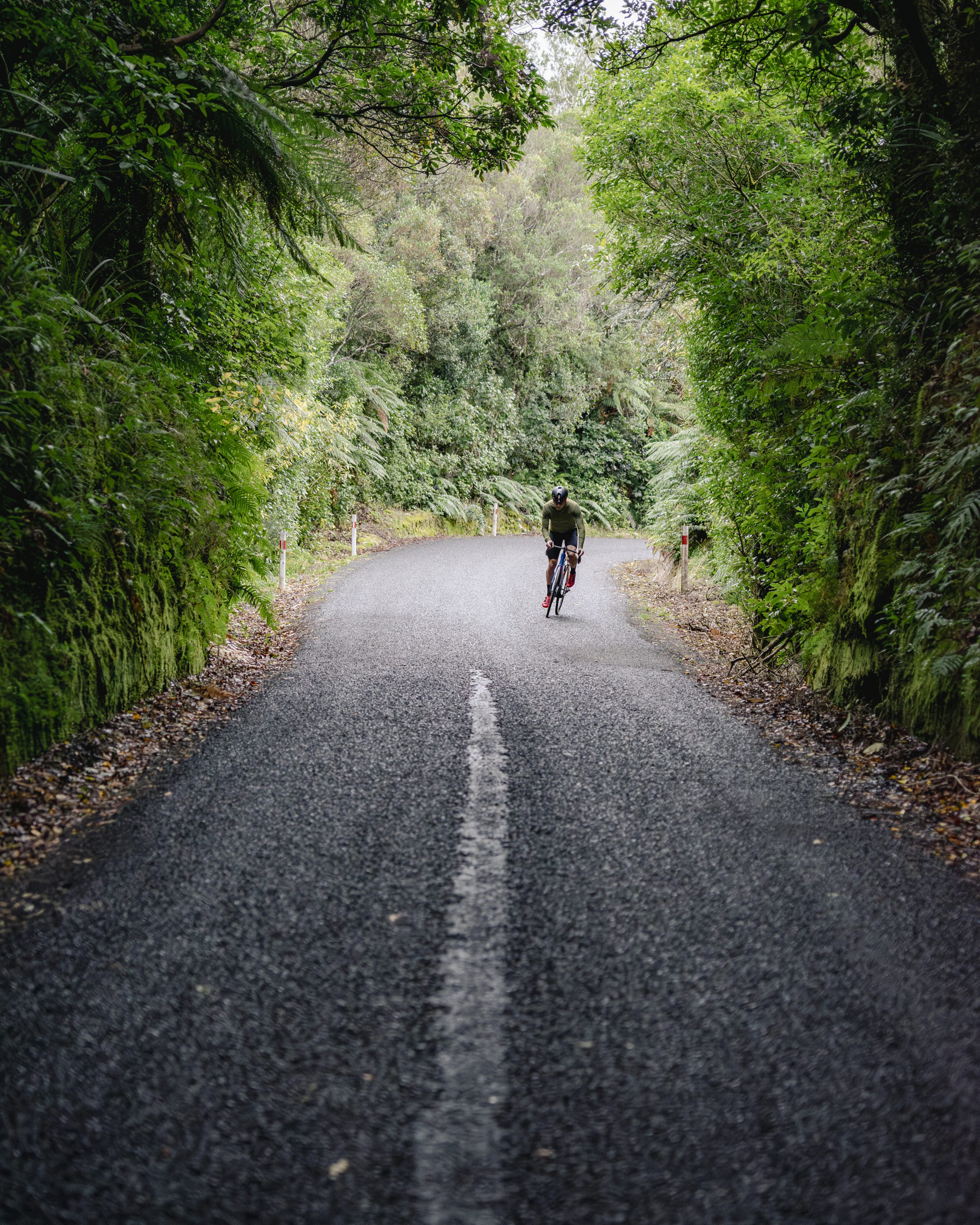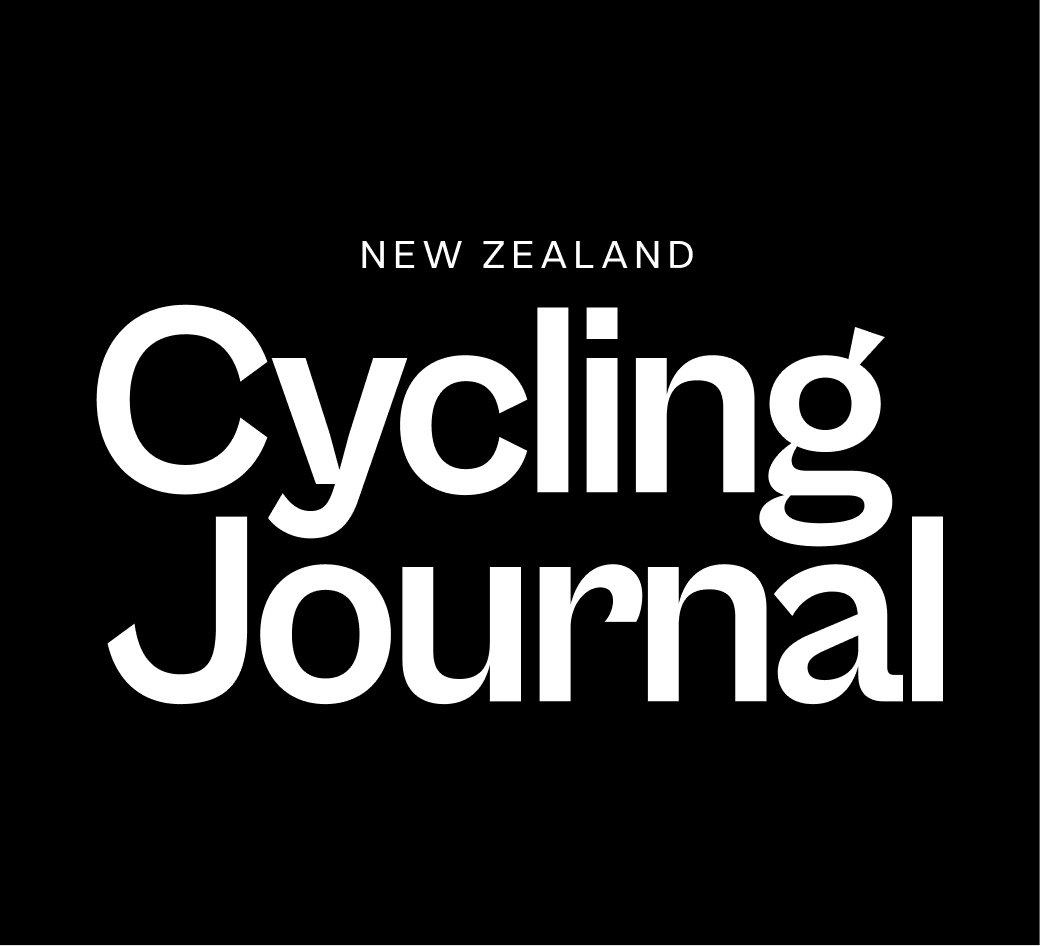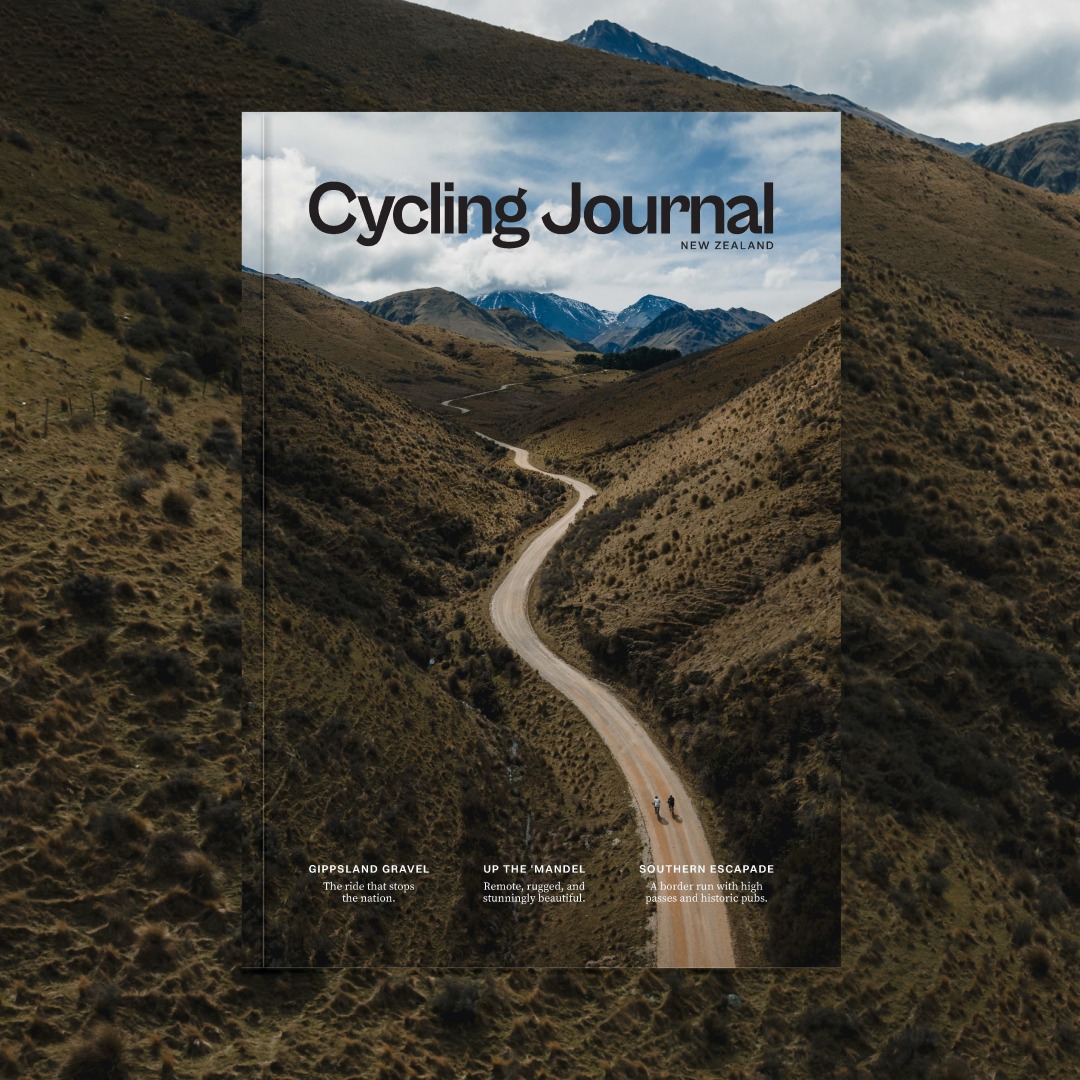Words: Lester Perry
Images: Jakob Lester
Why have two when you can have one? Does combining the best of two bikes make for a better overall package? We delve into the how and why of the new Generation 8 Trek Madone.
Introduced in 2003, the Madone began as a high-performance all-around race bike, focused on lightweight design and stiffness, ridden by none other than Lance Armstrong. By 2008, the Madone had evolved to meet the demands of a progressive peloton, adopting a compact-style frame resulting in lighter weight and greater stiffness without excessive harshness. By 2013, in its fourth iteration, the Madone introduced controversial (but aerodynamic) brakes behind the bottom bracket and KVF (Kammtail Virtual Foil) tubing, allowing for a relatively lightweight and comfortable yet aerodynamic ride—a unique combination at the time that cemented its position as an aero-focused all-rounder.
The Madone as we currently know it began in 2015 (Gen 5) when we saw a split: Madone delved deep into the aero world, embracing full integration and visibly larger aero tubes, utilizing IsoSpeed technology (carried over from the Domane) to maintain comfort for long days in the saddle. At this point, Trek introduced the Emonda as their lightweight climbing bike. Utilizing svelte tubing and lightweight carbon construction, combined with savvy component choices, the Emonda positioned itself as the lightest production road range at the time. Most recently, the third generation of Emonda, released in 2020, leaned slightly back towards aerodynamics in a quest to better balance weight and wind resistance, thanks to further integration and new tube shapes.
The launch of Gen 7 in 2022 saw Madone leap forward once again. This time, designers ditched the weighty, comfort-focused IsoSpeed technology in favor of a more aerodynamically efficient yet equally comfortable ‘IsoFlow’—a curious hole in the seat tube that forms an exhaust port of sorts for turbulent airflow coming off the rider’s legs, allowing air to pass through the frame rather than around it. The Madone’s weight was now closer to the Emonda, but with better aerodynamics and ride quality. Trek’s team riders were reaching for Madone in all but the steepest climbing races.
Here’s where things get a bit blurry for the Madone story.
A whole year before the Gen 7 Madone hit shelves, Trek’s design team was working on a refresh of the Emonda, aiming for it to regain its crown as a top-level, featherweight all-rounder with a penchant for rapid climbing. Taking into account some of their research and learnings from the Madone project while refining tube shapes for the new Emonda, it became apparent that the aerodynamic gap between Emonda and Madone could be significantly reduced. It was becoming clear they could create a bike as light as Emonda with almost equivalent aerodynamic advantages as Madone. The design team changed its goal to create a single “no compromises” frameset, a single race bike that would excel on every parcours.
In the last 12 months, we’ve seen other bike brands launch ‘do-it-all’, all-rounder bikes, light enough for the high mountain stages of Grand Tours and aero enough for breakaways or bunch sprints. So it was no surprise when we got wind that Trek was revising its range and launching something similar.
As we neared this launch, speculation of what this bike would be was rife; was it a new Emonda, new Madone? Maybe something entirely new? Trek’s marketing team did some great trolling, setting up graphics on team bikes with different versions of the Emonda and Madone names overlaid with an Infinity symbol that we now know was really the number eight. Keen eyes will have seen the Gen 8 Madone actually break cover at the Critérium du Dauphiné, 2024, as Mads Pedersen unleashed a bunch-beating sprint to win the opening stage.
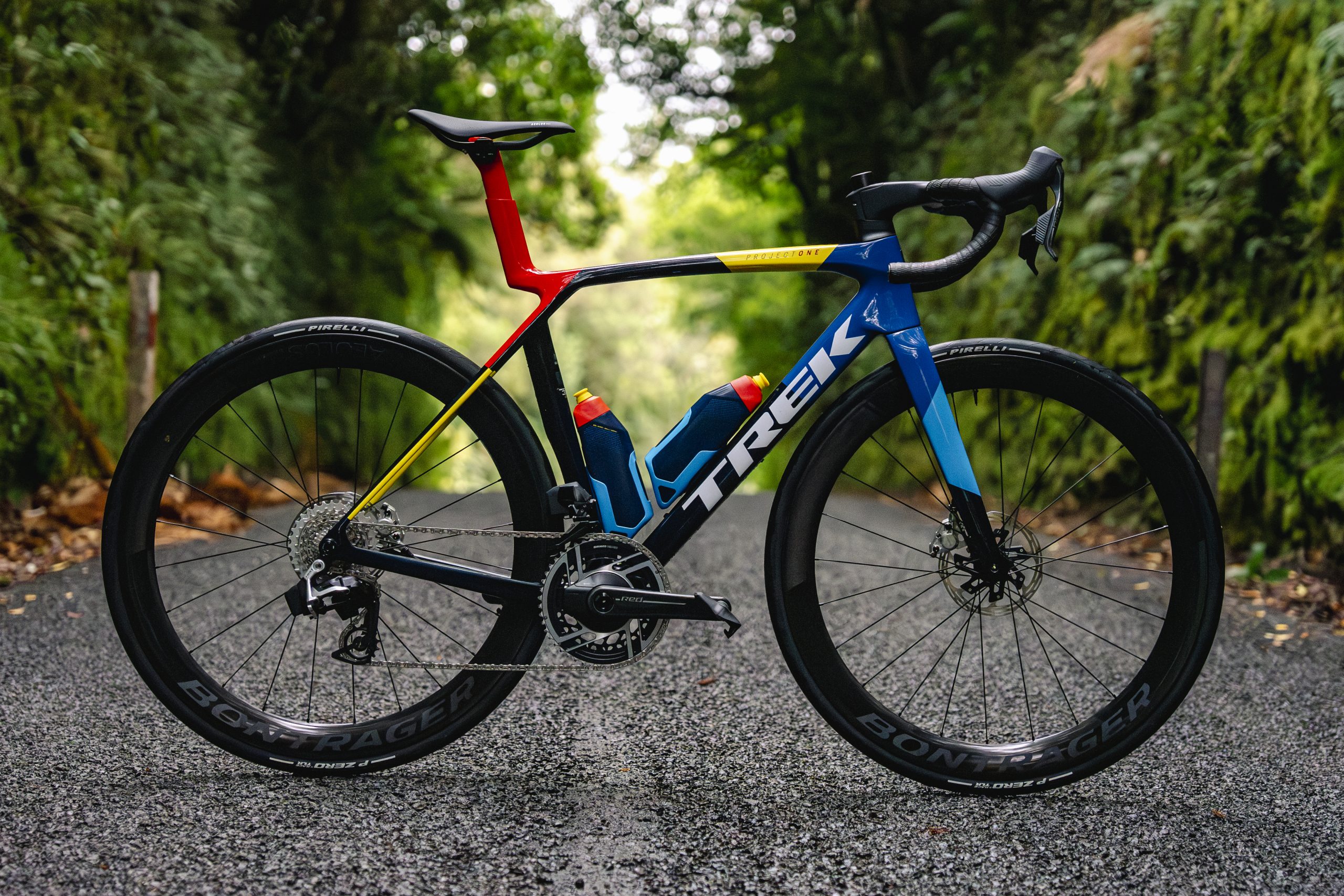
Development
Armed with the latest CFD (Computational Fluid Dynamics) and FEA (Finite Element Analysis) packages, engineers designed over 100 iterations, eventually creating three distinctly different prototypes. Taking them to the wind tunnel, with “Manny” the pedaling mannequin in place and variables (wheels, tires, etc.) all equalized and weight predictions calculated, they set to work to determine which prototype would be the fastest across all grades of road, from 0% to 12%. Once the data was collated and analyzed, the experts determined that prototype “C3” was likely the best option to achieve their goal of a single high-performance road bike.
Looking at the aerodynamic journey Madone has been on over the years, it began with classic round (and very non-aero) tube shapes. On Gen 4, the boxy ‘cut off’ KVF tubes were introduced. By Gen 5, tubes had stretched in size, with the bike taking on a classic “Aero bike” silhouette. Gen 6 pushed the aero gains with further optimized tube shapes, disc brakes, and the adjustable “IsoSpeed” for extra compliance at the saddle. Unfortunately, all this aero and comfort came at a price; the bike was portly at best. At first glance, it appears frame tubing on this fresh Gen 8 Madone has reverted to similar shapes and sizes to those on an early 2000’s Madone. But all is not as it seems.
To nail the sweet spot of aero vs. weight, Trek’s engineers devised a new cross-section of tube shapes dubbed “Full System Foil”. Using a newly developed cross-section generator that took a base profile and ‘pushed’ or ‘pulled’ the walls to different shapes while virtually testing it for aerodynamics and structural efficiency, they were able to create the perfect tube shape for a given use. The system guarantees they have the optimal combination of weight, structural integrity, and aerodynamics for each application across a frame. Interestingly, the use of this tool enabled hundreds of shapes to be trialed, even those that lay outside of a human designer’s understanding or comprehension; it looks suspiciously like another example of AI enabling a result that otherwise may have taken years, or never been reached at all by a human alone. The resulting tube profiles ended up surprisingly similar to KVF shapes but with rounder-shaped backs, resulting in better aerodynamics in rapidly changing wind directions and speeds with no need for countless, costly, and time-consuming physical prototypes.
The complete ‘Full System Foil’ incorporates the use of two specially shaped aero drink bottles; these work in conjunction with the seat tube, down tube, and wheels, effectively creating a virtual aerofoil from tip to tail of the bike. The bottles fill much of the gap between the downtube and seat tube, so fast-moving air flows smoothly over the entire system without the level of disruption caused by the empty space in the front triangle. This sort of thing has been done before, but not quite like this. The two bottles are identical, so they can be used in either position on the bike, and testing shows adding the bottles to any other bike adds aero gains. Although the bottle cages are unique in shape, the good news is that they’re compatible with standard bottles, albeit without the aero benefit. “So, is the bike as fast as the Gen 7 without the bottles?” I hear you ask. Trek was quick to answer, “The Gen 8 Madone is almost as fast as the Gen 7 Madone with standard bottles, and the aero bottles get us the rest of the way.” So expect to see Trek’s sprinters ensuring their bikes are fitted with the aero bottles as they’re coming into a sprint finish!
The new frame gets size-specific tube shapes—tweaked tube profiles to suit the frame’s size—which means optimal stiffness-to-weight-to-aero ratios, proportional aesthetics, and a better ride regardless of rider height. With older tube shapes, riders at either end of the size spectrum were not necessarily getting the most optimized ride characteristics. This new approach delivers the best ride and weight possible, whatever the frame size.
While on the subject of sizing, Trek has completely revised their sizing with this platform. Previously, eight sizes were offered, from 47-62cm; they’re now down to 6 sizes with less overlap in recommended rider height between them. Less overlap means it’s now easier to determine what size bike a rider would choose, although I guess the flip side is that there may need to be more customization to achieve the optimal fit. This new sizing also accommodates a more comprehensive range of heights, with both shorter and taller riders more easily catered to than before. Naming convention now moves to XS, S, M, M/L, L, XL, in line with their mountain bikes and certainly more familiar labels for non-cyclists to understand, although something new and potentially confusing for those used to a centimeter-based size.
As with previous Madone and Emonda offerings, the Gen 8 is available at two levels of frameset: SL and SLR. The SL level is the more budget-conscious of the two, featuring a 500 series carbon. The SLR is the top dog. It’s lighter weight than the SL, thanks to a new 900 series level carbon and revised manufacturing techniques. 900 series carbon is tougher and stiffer than its predecessor, the 800 series, therefore making this new frame up to 320g lighter than the previous Gen 7 equivalent. SL bikes come stock with a 2-piece handlebar and stem and routing for mechanical drivetrains and miss out on the aero bottles. SLR bikes get the fresh RSL 1-piece bar and stem, are compatible only with electronic drivetrains, and aero bottles are included as part of the package. It’s good to see Trek continuing with a T47 threaded bottom bracket across the range and adopting the now-industry-standard UDH derailleur hanger.
At a glance, it appears we’re getting the silhouette of the Emonda combined with the IsoFlow and aero seatpost of the Madone. The revised IsoFlow has shrunk overall, taking up less real estate, with a smaller hole and marginally tweaked shaping for better airflow. Consequently, it’s lighter weight and offers up to 80% more vertical compliance than the previous version, and a 24% increase over Emonda.
Does the release of this bike mean RIP for the Emonda? Almost. With the combining of the Emonda and Madone platforms, Emonda carbon models will cease to exist, although the Aluminium ALR line will stick around. Take into account the new sizing convention and that’s a total 55% fewer SKUs in Trek’s road line.
The complete bike weighs in at 7.5kg with bottles, cages, and a 22g Garmin mount, which are a crucial part of this bike achieving Trek’s aerodynamics claims. The bottles and cages combined weigh in at 274g. An all-rounder at 7.22kg is pretty competitive in the space and sits alongside other top-tier offerings.
Specs
The new Madone boasts an impressive specification, highlighted by SRAM’s newly launched RED AXS groupset. While we won’t delve too deeply into the groupset, as it’s only one part of the Madone experience, the brakes stand out as a significant improvement. A complete revision of ergonomics and mechanics elevates these brakes from acceptable to exceptional. The hoods are possibly the most comfortable I’ve ever used, with their longer design providing more room between the bars and the hood. This allows for larger hands, a variety of hand positions, and improved aerodynamics when riding on the hoods. Braking power and modulation are significantly improved over previous versions, and with the lever’s pivot point moved upwards, braking from the hoods is much more comfortable and requires less effort.
Shift buttons are accessible from any hand position, whether using the traditional paddles on the brake levers or the buttons on the inside of the hood tops. The entire groupset performs admirably, with one minor drawback: the shift buttons on the hoods lack a positive ‘click’ feeling, occasionally leaving me unsure if I’d pressed the button sufficiently. This became particularly challenging with cold hands.
The Gen 8 SLR features a new Trek RSL one-piece stem and bar combo incorporating the new Full System Foil shapes. Nicknamed “the Chonky” by the design team, the hoods sit 30mm narrower than the bottom of the drops, and the tops sweep back slightly from the stem. This combination is exceptionally comfortable, replacing the flat tops of old with more rounded Full System Foil shapes. These are far more comfortable in hand, and the back sweep feels more natural than a traditional ‘square’ bar.
Upon unboxing the bike, I noticed the internally routed brake lines and initially worried about potential setup difficulties. Fortunately, adjusting the stem to my preferred height wasn’t overly complicated, and the segmented headset spacers were user-friendly. A stem and spacer cover maintains a tidy cockpit appearance even with an uncut steerer. An alternative cover that conceals the top cap is available for a sleeker look when the steerer is cut flush.
The bike is equipped with Bontrager Aeolus RSL 51mm rims laced to hubs featuring DT Swiss 240 Ratchet EXP 36-point engagement internals, a proven combination. These wheels offer stability at speed, comfort, and good crosswind handling, contributing significantly to the bike’s overall performance. The specified Pirelli P-Zero Race TLR tires measure 29.4mm on these rims, providing excellent grip and comfort. The frame offers ample clearance for tires up to 32mm or larger, which would be ideal for races featuring cobbled sections.
The Ride
I’ve thoroughly tested the Madone Gen 8 SLR 9 AXS over the past three weeks on my regular routes in central Waikato. Riding familiar roads has been ideal for experiencing the nuances of this exceptional machine.
The Gen 8 Madone embodies the phrase “It goes like a cut cat,” an expression my father used to describe high-performance sports cars. It’s quick off the mark and snappy through turns. Once up to speed, it maintains momentum effortlessly, changes direction quickly and easily, and stops on a dime.
There’s something special about riding a bike of this caliber. While the basic contact points—saddle, pedals, and bars—are similar to most road bikes, the low weight and responsive ride are immediately noticeable. For those accustomed to high-end bikes, the Madone still represents a significant step up in performance and feel.
The bike truly shines at cruising speed. On a 1.5km flat section of one of my local loops, I compared it to my usual semi-aero bike with 45mm deep wheels, using the same kit and helmet. Starting at a leisurely 28 km/h and accelerating to 45 km/h, the Madone not only felt marginally easier to bring up to speed but also reached that speed more quickly. Once there, I could maintain that speed more comfortably and with less effort than on my regular bike. This improved performance is evident everywhere: rapid acceleration and easier speed maintenance over punchy climbs or long flat sections are genuinely exhilarating.
The bike’s light weight is particularly noticeable when climbing, especially on steep sections out of the saddle. There’s a lively, positive feel, as if all your energy is being efficiently converted into forward motion. On longer, more gradual climbs at higher speeds, I found I could comfortably use a gear or two higher than on my regular ride.
Descending on the Madone is a dream, significantly outperforming the current Emonda, which I found overly stiff and harsh in the front end. The Madone descends rapidly, with the wheel and frame combination providing a smooth, locked-in feel through turns, even on rough road surfaces. Direction changes at high speed are smooth and effortless, thanks to excellent geometry and a bike that feels exceptionally balanced, stable, and planted. I had no hesitation throwing the bike into tight turns at speeds far exceeding what I’d attempt on other bikes on the same roads.
Comfort is a key feature, and I was pleasantly surprised by how comfortable the bike is, even on New Zealand’s rough chip seal roads. Square-edge impacts are softened by the IsoFlow’s compliance, while general road vibration is dampened by the 28mm tires and thoughtful carbon layup in the wheels and frame. For a bike with such a strong focus on aerodynamics, it offers impressive comfort without compromising performance.
I had ample opportunity to assess the bike’s crosswind performance as autumn winds swept across the Waikato plains. Remarkably, there was little to report; the bike showed minimal effect from crosswinds, certainly nothing compared to my experiences with more traditional aero bikes in similar conditions. While I haven’t ridden the Gen 7 Madone in these conditions, I’m confident this new model represents a significant improvement in crosswind handling.
I’m curious about the lateral stiffness of the bottom bracket compared to the previous model. During all-out sprints—not quite at the level of Jonathan Milan’s Giro-winning 1940 watts, but around a more typical 1350 watts—the bottom bracket doesn’t feel overly stiff. I suspect it may be less rigid than the Gen 7 Madone. This doesn’t necessarily translate to slower performance and could be partly due to the 28mm tires. It would be interesting to see empirical data on this aspect.
From a cynical perspective, this project—combining two models, restructuring sizing, and reducing the total number of bikes in their range—suggests Trek is adopting a more conservative approach in response to a shrinking market segment. It appears they’re streamlining their offerings, recognizing that highly specialized bikes at the top of the range may no longer be the most viable strategy in the current industry climate.
Personally, road bikes don’t usually excite me; road riding is often a means to an end, either for off-road training or when time is limited. However, the Madone has been refreshing. I’ve found myself genuinely looking forward to road rides, partly because I subconsciously know that the only limiting factor is myself—this is truly a “no excuses” bike. Despite my best efforts, I’ve struggled to find any significant faults with this bike. The bottom line is simple: it’s incredibly fun to ride, and the faster you go, the better it gets.


